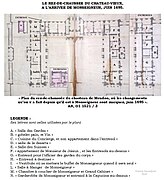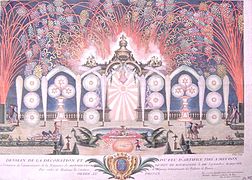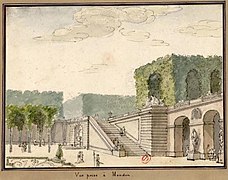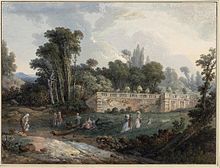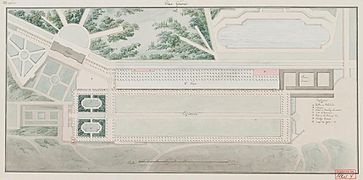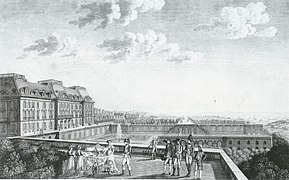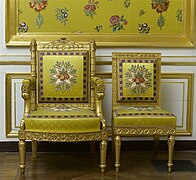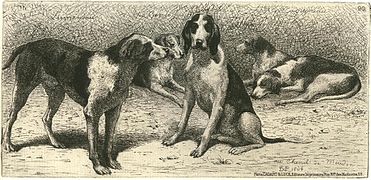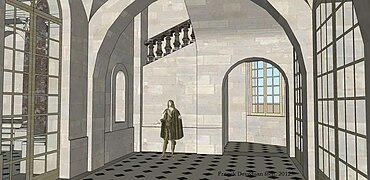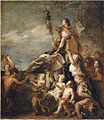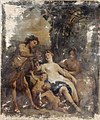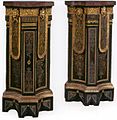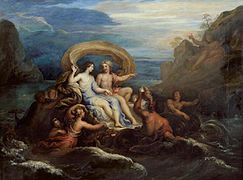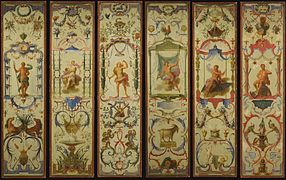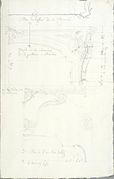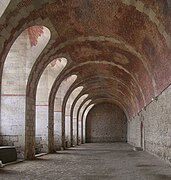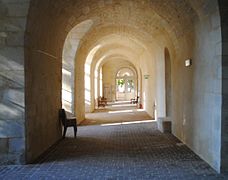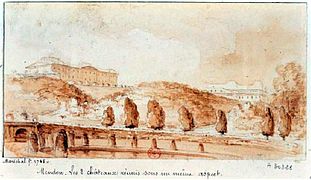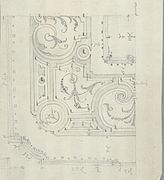Château de Meudon - Château de Meudon
Bu makale kaba tercüme Fransızcadan. Bir bilgisayar tarafından veya çifte yeterlilik olmaksızın bir çevirmen tarafından oluşturulmuş olabilir. |


Meudon KalesiKraliyet Kalesi olarak da bilinir Meudon veya İmparatorluk Sarayı Meudon bir Fransız kalesidir. Meudon içinde Hauts-de-Seine Bölüm. Ormanlık bir platonun kenarında yer alan kale, Paris ve Seine nehrin yanı sıra Chalais vadisi. Arasında bulunur Paris ve Versailles bir av rezervinin kalbinde, kalenin bir ideali vardır. topografya büyük bahçeler için. Ardı ardına gelen birçok sahibi vardı. Rönesans düşüşüne kadar İkinci Fransız İmparatorluğu. İle karıştırılmamalıdır Bellevue Kalesi ayrıca yer almaktadır Meudon.
Ünlü geçmiş sakinler şunları içerir: Anne de Pisseleu d'Heilly, Étampes Düşesi; Lorraine Kardinali, Abel Servien; François Michel Le Tellier Marquis de Louvois ve Louis, Büyük Dauphin, Ayrıca şöyle bilinir Monseigneur, kim bağladı Chaville Kalesi Meudon Kalesi'ne. Château-Vieux (Eski Kale) 1795'te yandı ve Château-Neuf (Yeni Kale) olarak yeniden inşa edildi ve 1871'de yanarak yıkıldı. Yıkım düşünüldü, ancak kalenin çoğu korundu ve bir gözlemevi oldu. astronomik teleskop 1878'de, daha sonra Paris Gözlemevi 1927'de.
Etki alanı Meudon 12 Nisan 1972'den beri tarihi eser olarak sınıflandırılmıştır. Hangar Y Chalais-Meudon parkında 4 Haziran 2000 tarihinden beri tarihi anıt olarak sınıflandırılmaktadır. aerostatlar dünyada ve hala ayakta duran birkaç kişiden biridir.
Tarih
"Versailles'da yapılan harcamaların hem yerleşim planı hem de konumu itibariyle dünyanın en güzel yeri olan Meudon'da yapılmasını bizim yaptığımız gibi dileyen çok az mimar vatandaş veya aydınlanmış yabancı var." - J. F. Blondel, Cours d'Architecture ..., 1773, cilt 4, s. 132.

Orta Çağ'ın sonunda Meudon
Meudon'un Efendileri (1200'ler-1413)
Kesinlikle küçük olan kalenin kökeni hakkında çok az bilgi var. castel | castel. Orijinal kat planı bilinmiyor. Bununla birlikte, "Meudon" adlı 12. yüzyıl lordlarının birçok kaydı ve 14. yüzyılda bir "Meudon vadisinin malikanesi" nden söz edilmektedir. Marie-Thérèse Herlédan kitabında bu dönemin bir kaydını yayınladı Meudon, Avant le Roy (Kralın Önünde Meudon). Birçok Meudon mahkemede görev yaptı, Robert de Meudon, Fransa Grand Panetier Kralın altında Philip the Fair. 1305 yılında bir senedde unvanı zikredildi.
Augustin Isbarre (1413-1425)
17 Temmuz 1413'te, Hermit olarak bilinen Jean de Montrevel, La Faye, Chamberlain Kralın ve kalenin tımarının sahibi Jeanne de Gaillonnel'in kocası, kaleyi eşinin rızasıyla zengin Augustin Isbarre'ye sattı.[1] bankacı ve kuyumcu.[2] 1422'de ailesi kraliyet ailesi için mali hizmetler yapmış olan Isbarre,[3] atandı bakıcı kralın. 27 Ağustos 1425'te Paris'te öldü[4] ve gömüldü Grands Augustins Manastırı.
Rönesans
Sanguin ailesi ve Duchesse d'Étampes (1426-1552)
Tımar Meudon tarafından 1426 yılında satın alındı Guillaume Sanguin, valesi Charles VII ve Burgundy Dükü'nün veznedarı. Daha önce, 1429'dan 1431'e kadar Paris tüccarlarının eski sahibi Augustin Isbarre ile ilişkilendirildi. Görünüşe göre eski kalenin yerine bir malikane inşa etmişti. 14 Şubat 1441'de Paris'te öldü.
"Sanguin'in Piçi" olarak bilinen Jean Sanguin, sekreterlik babasının; 13 Kasım 1468'de Paris'te öldü. Birçok çocuğu vardı, aralarında Antoine Sanguin de vardı. sert ve Meudon'un lordu oldu. Antoine daha sonra Marie Simon ile evlendi ve 18 Ekim 1500'de öldü.
Malikane 1520'de Antoine Sanguin, bir meydan inşa eden önceki Cardinal de Meudon'un oğlu Cardinal de Meudon olarak bilinir. corps de logis tuğla ve taştan, süslü tavan pencerelerine sahip bir zemin katta çatı katı ile. İtalyan tarzında süslenmiştir. pilastörler bantlar ve taş çerçeveler. Kalenin düzeni, sözde Château du Grand Jardin, içinde Joinville, de Guise ailesine ait bir mülk. Antoine Sanguin kaleyi yeğenine verdi Pisseleu Anne, 5 Eylül 1527'de. François I ve neredeyse fiili Fransa kraliçesi. François, metresine daha iyi uyum sağlamak için, ilk gövdenin her iki tarafına iki kare pavyon ve aynı pavyonlarla biten iki kanadın eklenmesini finanse etti. Bu uzantılar ana binanın tarzını yansıtıyordu. Tarzında Château d'Écouen, bindirmeli köşe taretler pavyonlara da eklendi. Yapı, şatoda yapılan işlere benziyordu. Marchais, Aisne, daha sonra, Champagne ve Brie valisi ve Étampes Düşesi'nin yakın çevresinin bir üyesi olan I. Francois yönetimindeki Bossut Kontu ve Maliye Müfettişi Nicolas de Longueval'e ait. Halen bilinmeyen aynı mimar, Meudon ve Marchais'in yanı sıra komşu kalenin genişletilmesine de başkanlık etmiş olmalı. Sissonne, hepsi aynı tarzda. Avluya görkemli bir giriş görevi gören çit duvarının ortasına da bir zafer takı inşa edildi.
Fransa Francis I Meudon'da 11 Temmuz 1537'den 5 Ağustos'a kadar kaldı. 1547'deki ölümüne kadar birçok kez orada kaldı.
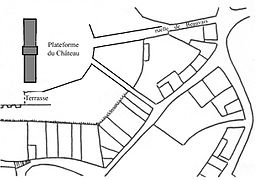
1520 civarında Antoine Sanguin kalesinin yerini gösteren Meudon köyünün çizimi

1520 dolaylarında Meudon kalesinin yorumlanması. (Gelecekteki merkezi yapı)

1520 civarında Antoine Sanguin tarafından inşa edilen Meudon Kalesi. Birinci katın düzeni
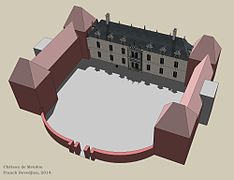
1540 dolaylarında Pisseleu Anne tarafından yapılan eklemeler

Meudon'daki eski kalenin eski ağzından görünümü ruelle de Beauvais. 16. yüzyılın ortasındaki durum

16. yüzyılda Meudon ile aynı zamanda ve aynı mimar tarafından inşa edilen Marchais kalesi (kale korunmuş, Grimaldi Monako ailesi)
Lorraine Kardinal ve de Guises (1552-1654)
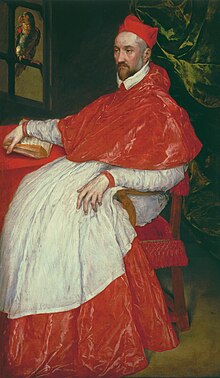

I. Francis'in ölümü üzerine, o zamanlar utanç içinde olan Anne de Pisseleu, 1552'de Meudon malikanesini satmak zorunda kaldı. Charles de Guise, Lorraine Kardinali.[5] Bu, Sanguinlerin bir asırdan fazla süren Meudon'daki varlığı ile sona erdi. Eski favorim geri çekildi Château d'Heilly, Eylül 1580'de öldüğü yer.
Kardinal daha sonra, Roma'ya yaptığı seyahatlerde keşfettiği İtalyan mimari tarzından ilham alarak konutu yeniledi. 28 Aralık 1552'de kayınbiraderi Anne d'Este'ye hitaben yazılan bir mektupta şöyle diyor: "Paris'teyken Meudon'daydım ve evin bittiğinden emin olmanızı rica ediyorum .. .bu krallıkta artık güzel evler yok ... "

Kardinalin kanatları, bir terasla örtülü bir galerinin avlu tarafında, Francesco Primaticcio. İç mekanlar, Trent Konseyi Muhtemelen İtalya'da aynı anda yapılanlar tarzında Kardinal'in aktif olarak katıldığı Taddeo ve Federigo Zuccaro. Teraslı bahçeler ve limonluk adanmış küçük bir fantezi sarayı da dahil olmak üzere küçük binaların etrafında yaratılmıştır. periler ve muses, yine Primaticcio'nun 1552 ve 1560 yılları arasında yaptığı çizimlere dayanan ve sanatçının besteleriyle dekore edilmiş ünlü "Meudon Mağarası". Bir pasaj platformunun altında, onu kaleden görsel olarak ayıran bir tepe tarafından korunaklı, küçük bir saray oluşturur. İsrail Silvestre mağarayı temsil eden. İkincisi, aslında İtalyan ve Fransız stillerini harmanlayan, yamaca dayanan üç pavyondan oluşuyor. Merkez pavyon mağarayı düzgün bir şekilde korudu, mozaikler, deniz kabukları, mercanlar ve Maiolica ve ana yüklenicisi Primaticcio'nun kendisi. Merkez pavyonun birinci katında büyük bir salonda antikalar sergilendi. Tarihçi Henri Sauval yazdı ki Versailles Diana İtalya'dan getirilmiş ve Meudon kalesine yerleştirilmişti, ancak son araştırmalar aksini kanıtlıyor gibi görünüyor.[6] Bu mağara anında başarı elde etti ve övgü aldı Pierre de Ronsard "Chant pastoral sur les noces de Charles, duc de Lorraine et Madame Claude, fille du roi" adlı eserinde (Charles'ın Düğünü Üzerine Pastoral Şarkı, Lorraine Dükü ve Kralın kızı Madame Claude).[7]
1568'de, Giorgio Vasari Şöhreti İtalya'ya kadar ulaşan mağara hakkında hevesliydi: "Meudon'da, Lorraine Kardinali adına Primaticcio, La Grotte adlı büyük sarayında antik çağların banyolarını anımsatacak kadar olağanüstü büyüklükte pek çok dekorasyon gerçekleştirdi. galerileri, merdivenleri, kamuya açık ve özel dairelerinin sonsuz sayısı ve büyüklüğü nedeniyle. Bu mağaranın inşası, mağaranın kendisinin ve merdivenin iki rampasının (yaklaşık 1552-1555) inşasından başlayarak zamana yayılmıştır. ) ve sonra ikinci aşamada iki pavyon (1559). Cryptoportico daha sonra üçüncü bir aşamada inşa edildi.

1574'te Lorraine Kardinali'nin ölümünde, kale, tımarlardan biri olduğu Guise ailesinin ve kale ile birlikte mülkü olarak kaldı. Joinville, Haute-Marne.
Meudon, Din Savaşları. Ve Meudon'da gelecekteki Henri IV (Henry IV) suikastı öğrendi Fransa Henry III 1 Ağustos 1589'da Jacques Clément'ten. Navarre'lı Henry aynı gün yakındaki yaralı kralı görmeye gitti. Saint-Cloud. Kral, sağlık durumu hakkında ona güvence verdi. Henri, Meudon'a geri döndü. Maximilien de Bethune, Sully Dükü ona eşlik eden, köydeki bir ev olan "Sauvat" a yerleşti. Ertesi gün, kralın durumu kötüleşti ve Saint-Cloud'da öldü. Navarre Henry, ilk Bourbon kralı olan Fransa Kralı oldu.
Henri de Guise, Meudon'u çok az ziyaret etti. 1588'de suikasta kurban gitti. Meudon, Lig'in koltuklarından biri oldu. 24 Temmuz 1605'te Francois de Bourbon, Conti Prensi (1558-1614) evli Louise Marguerite de Lorraine şatonun şapelinde. 1618'de, Lorraine Dükü mimarına, Gabriel Soulignac kalenin tadilatı ve bahçelerin genişletilmesi ile.[8] Diğer işler 1623'te Soulignac tarafından bir teras ve mağaranın yakınında bir merdiven inşası ile gerçekleştirildi.
1639'da Jacques Dubreuil, Meudon'un merdivenleri ve taretleriyle övünüyordu: "Bahçe orta büyüklükte, çiçek tarhlarından, sınırlardan, açık ara yollardan, güzel ağaçlarla kaplı sokaklarla çevrili, korkuluklu." 1641'de ressam Nicolas Poussin Meudon'u ziyaret etti, şüphesiz Primaticcio'nun ünlü süslemelerinin ilgisini çekti. Her şeyden önce, 18 Mayıs 1643'te Gaston d'Orléans, erkek kardeşi Louis XIII ile Lorraine Marguerite, Paris Başpiskoposu'nun kutsamasıyla kalenin şapelinde yenilenmiştir.
Alan adı altında yağmalandı Fronde Meudon'un sahibi olan Lorraine prensleri, kraliyet otoritesine karşı isyanın tarafını tuttuğundan beri. Böylece, 1649'dan başlayarak, Grand Condé Kraliyet ordusunun başında Charenton, Saint-Denis, Saint-Cloud ve Meudon'u ele geçirdi.
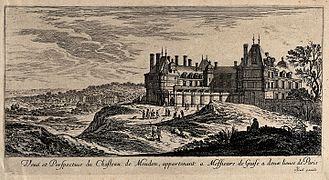
Meudon kalesinin görünümü, yaklaşık 1600. Gerçekte, Meudon köyü şifreleme duvarının arkasında duruyordu.
Meudon Mağarası, İsrail Silvestre tarafından, on yedinci yüzyılın ilk yarısı

Meudon mağarası, yazan Claude Chastillon, yaklaşık 1600
Grand Siècle
Abel Servien ve Marquis de Sablé (1654-1679)
Kötü durumdaki Meudon daha sonra 12 Eylül 1654'te Abel Servien, Maliye Müfettişi Baron de Meudon unvanını alan. Servien, satın alma yapılır yapılmaz, mimar tarafından kapsamlı bir yenileme çalışması yaptırdı. Louis Le Vau. Kariyerinin zirvesindeydi ve Meudon'un bu gücü yansıtması gerektiğini hissetti. Paris'te Servien, Paris'in yakınındaki Hôtel de la Roche-Guyon'da yaşıyordu. Palais-Royal En azından 1651'den 1659'a kadar. Kale daha sonra zengin bir şekilde döşenmiş ve dekore edilmiştir. Orta ön güvertenin yerini, tepesi kesik piramit şeklindeki yüksek bir çatı ile örtülmüş sekizgen bir pavyon aldı. Pavyonun ortasında büyük bir çift sarmal merdiven vardı. Önünde on iki sütun mermer monolit ile süslenmiş büyük bir merdiven var. Birinci katta büyük bir kupolalı o zaman inşa edilene benzer şekilde bahçelere açılan salon Nicholas Fouquet şatoda Vaux-le-Vicomte. O, Servien'in Maliye Müfettişiydi ve kendisinden daha büyük olan Servien'in yetkisi altındaydı. Servien, kalenin manzarasını netleştirmek için ön avluya inşa edilmiş geniş bir teras yaptırdı ve böylece başka bir yere taşındığı Meudon köyünün neredeyse üçte birini yuttu.
Bahçe tarafında, bugün hala korunan anıtsal bir limonluk inşa etti. En azından Duchesse d'Étampes'tan beri var olan parkı büyüttü. Birçok arazi satın alımıyla, kalenin güneyinde, Chalais'inki de dahil olmak üzere havzalar ve göletler içeren bir "Büyük Perspektif" oluşturmayı başardı. Mektuplar patent 31 Ağustos 1657 tarihli "Meudon parkını genişletme, edinilen miraslar Majestelerinin zevkleri mahallesinde olmasına rağmen duvarlarla çevreleme", diğer bir deyişle komşunun iznini taşır. Versailles Sarayı.
Kraliçe ne zaman İsveç Christine Fransa'ya geldi, Servien'e bronz teklif etti Adrian de Vries, Merkür Ruh Kaçırıyor, şimdi Louvre'da.[9] Servien bu bronzları çiçek tarhının sonuna, yenisinin hemen üstüne yerleştirdi. limonluk.
Servien 17 Şubat 1659'da Meudon'da, zemin kattaki dairesinde, hala yapım aşamasında olan Meudon'da gerçek bir servet harcayarak öldü.
Onun oğlu, Louis-François Servien, marki Sablé, koruyucusu Jean de La Fontaine, mülkü yirmi yıl sakladı. 2 Ağustos 1665'te, Gian Lorenzo Bernini Meudon'u ziyaret etti.
Mali kısıtlamalar sonunda Louis-Francois Servien'i Meudon'u François Lemoine de Louvois 1679'da. Zaten, bir yıl önce, 1678'de, Académie Royale d'Architecture Meudon'u ziyaret etti ve "M. Servien'in zamanlarında kalenin bahçe tarafında yenilenen şeyin çok harap olduğunu, özellikle de korniş merkezi köşkün ". (P.V.I. 193).
1659'da Abel Servien'in ölümündeki kale
Meudon'un parteri ve "Mercury and Psyche" heykeli, yaklaşık 1660.

Merkür ve Ruh, bronzlaştıran Adrien de Vries.

Servien'in 1654'te bulduğu eyaletteki mağara, Fronde.
Servien ailesinin kolları.
1659'da Servien'in ölümünde eski kalenin birinci katının düzeni.
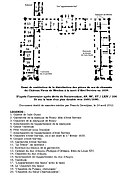
1659'da Servien'in ölümünde eski kalenin zemin katının düzeni.
Büyük Teras'ın oluşturulmasından önce, 1654'teki kale girişinin ve köyün çizimi. (Marie-Thérèse Herlédan, Bulletin des Amis de Meudon).
Meudon'un Abel Servien altında evrimini gösteren diyagram.
Tarafından tamamlanmamış proje Louis Le Vau Vieux-Château'nun merkezi pavyonu için. Yaklaşık 1655.
Louvois ve eşi Anne de Souvré (1679-1695)


Gençliğinde kendisini "M. de Chaville" olarak adlandıran güçlü bakan için Meudon bölgesi, hem Versailles hem de Şato'nun yakınında idealdi. Chaville, aile mülkünün bulunduğu yer. Babası tarafından yeniden inşa edildi, Michel Le Tellier. Louvois, 1683'te binaların denetimini elde etti, ardından bir dizi görkemli yeniden düzenlemeye başladı. Şatonun cephesini gri mermer sütunlar üzerinde büst ve balkonlarla zenginleştirdi. Tüm iç mekanı görkemli bir şekilde yeniden dekore etti. 1684 yılında ahşap işleri yaptırdı. Kapıların üstünde, stilinde çiçek resimleri vardı. Jean-Baptiste Monnoyer. Bir dolapta yaşlı Jean Cotelle tarafından boyanmış Versailles bahçelerinin minyatürleri sergilendi, şüphesiz 1688'de Louis XIV'den mermerin mükemmel bir şekilde tamamlanması için bakanına teşekkür etmek için bir hediye Trianon de porselen. Birinci katta sağ kanadın tamamını kaplayan büyük galeri, on iki resim ile bezenmiştir. Adam Frans van der Meulen saltanatının büyük savaşlarında.
Genç Nicodemus Tessin 1687'de kaleyi ziyareti sırasında şunları kaydetti: "Meudon'da bir Gascon beyefendisi (M. Le Cas adında eski Mısır'ın tüm görüşlerini çeken) ve M. Silvestre ile gittim ... Ev, M. de La Fosse tarafından doğrudan kasanın üzerine yağlı boya ile boyanmış tavandı. Kompozisyonun dört köşesinde, alçı sıva simülasyonu, iki oturan figür ve iki ayakta figür boyandı: köşelerde ve heykellerin arasında, tavan doğrudan kasanın üzerine yağlı boya ile boyanmıştır. Charles de La Fosse. Köşelerde ve heykellerin arasında bir şey vardı oeil-de-boeuf içinden gökyüzü görülebiliyordu. Figürlerin yanında ve onları daha iyi öne çıkarmak için, farklı renkteki zengin halılar ve ilk ve diğer köşe arasında ortası tasvir edilen büyük ovaller Pandora. Yanında, Merkür özellikle iyi boyanmıştı. Tonoz üst kısım boyunca uzanıyordu korniş ve aşağıdaki gölge çok iyi bir etki yaptı. Büyük sıva Listeler her yer tamamen yaldızlıydı. Bitişik oda da M. de La Fosse tarafından boyanmış olmalı. Yukarıdaki oval odada aynalar çok iyi bir izlenim bıraktı. Dairesel olarak düzenlenmişlerdi ve beş pencere kadar uzunlardı. Sadece yarı yüksekliğinde bir ahşap işçiliği vardı. Her panele, yaklaşık 6 qv'lik üç buz tabakası yerleştirildi. Yüksek ve panelin ortasındayken, aynı anda üç pencerede birbirinizi görebiliyordunuz. Galeri bir dizi jasper masası, büst vb. İle güzelce dekore edilmişti ve Kral'ın tüm eylemleri tarafından boyanacaktı. Van der Meulen; İki tanesi zaten tamamlandı. Galerinin bir ucunda, masanın ve iki pencere arasındaki tüm panelin ayna camıyla kaplandığı bir misafir odası vardı ve kapıların açılması o kadar büyüktü ki, Uzak, neredeyse tamamını görebiliyordu. galeri. Dahası, çok sayıda güzel, çok büyük aynalar var. Mobilyalar çok güzeldi, ama tuhaf bir tadı yoktu. Toprak nemi nedeniyle tüm kışlar kaldırılır. Altında, M. de Louvois'in kendi odasında, ısının isteğe göre geçmesine izin veren üç bakır boru vardı. Bu ısı, komşu odanın bacasına yerleştirilen bakır bir sobadan geldi. Girişin altından geçen bir havalandırma borusu bu bacaya ulaştı ve daha sonra bu odanın penceresi açıldığında (Versailles'daki "ısıtma makinesi" gibi) ısıyı dağıttı.
Ahırın yanlarından birine taş veya payandalarla taşınan evin dışı çok kötü durumda. Site mümkün olana kadar sağlam ama yine de çok hoş. Terasların önündeki bahçede aşağıda bulunan orta koridor çim kaplı ve 70 metre genişliğinde; Sonra, sekiz metre genişliğindeki kumlu bir sokağın ortasında ladin ve diğer ağaçlar var; Sonra, iki yanda dokuz metrelik yeni bir çimenlik ve yine sekiz metre genişliğinde ağaçların olduğu kumlu bir sokak. M.'nin parteri Le Nostre Ortada, çizdiğim mağaranın önünde çok güzel, bu yüzden evin önündeki ortadaki iki "nakış", oval çanağın etrafında iki mermer vazo ve mermer heykellerle, el yapımı olarak fayanslar kötü bir etki yapmadı. Portakal ağaçlarının kutularını da ayrı ayrı çekip oraya çizdim. Bu bahçe ve park çevresi en az yedi millik bir duvarla çevrilidir. Bahçenin dibinde M. de Louvois'in ömür boyu M. Honoré Courtin Courtin için satın aldığı bir başka büyük eğlence evi vardı.
Dışarıda, Louvois'in parkın su yollarına güç sağlamak ve en muhteşem su jetlerine izin vermek için kapsamlı hidrolik işleri vardı. Üst park geliştirilirken Le Notre 1680'ler boyunca sürekli olarak bahçelerde çalıştı ve hemen hemen tüm alt bahçeleri yarattı, Grotto'nun önündekiler de dahil olmak üzere yeni korular ve partereler icat etti. Louvois ayrıca, kalenin ihtiyaçlarını karşılamak için kalenin caddesi boyunca büyük bir sebze bahçesi, daha sonra Dauphin'in sebze bahçesi olarak anılacak bir sebze bahçesi düzenlemiştir. Kısacası, XIV. Louis'in Meudon'da daha muhteşem bir şekilde yaptığı her şeyi, aynı zamanda Versailles'da inşa ediyor. Ve sordu İsrail Silvestre çizim ustası Louis de France Silvestre'nin yaptığı işin en özenli olanları arasında, çok muhteşem birkaç baskı ile tüm araziyi oymak.


Temmuz 1681'de Fransa Kraliçesi, Avusturya Maria Theresa (1638-1683) "Bay de Louvoy'un kendisine hizmet etme şerefine sahip olduğu" Meudon'u ziyarete geldi (d Temmuz 1681'deki Mercure Galant'tan sonra) Louvois, 17 Ağustos 1684'te Meudon için büyük bir ziyafet hazırladı. Orleans Philip (1640-1701). Kral ve eşi, özellikle 2 Temmuz 1685'te komşu Saint-Cloud kalesinin sahipleri, Louis XIV, Louis de France Dauphin, Dauphine, Mösyö ve Madam, "Saray Prensleri ve Lordlarının büyük bir kısmına eşlik eder", Meudon'a gelirler, burada Louvois Kral'a ve tüm Saray'a "İhtişamla" muamele eder. Muhteşem bir harmanlanmıştır. Operadaki tüm keman ve obuaların melodiler çaldığı Jean-Baptiste Lully "(...)" Ama M. de Louvo Kralın yanında olduğu sürece memnun olduğunu görünce üzgündü. "1686'da, Meudon'a hala Siam elçilerinin onuruna bir resepsiyon verilir. hem bahçeleri hem de kaleyi keşfetti. Louvois, birlikte olduğu için onları kabul etmek için orada değildi Bakım ve Kral, Eure kanalındaki çalışmaları takip edecek. 25 Ağustos 1689'da Louvois, Meudon'daki akşam yemeğinde yine Orleanslı Philip'i (1640-1701) kabul etti. 29 Haziran 1691'de, Louvois'in ani ölümünden iki hafta önce, "Monseigneur, Madame Princesse de Conti ile Meudon'a gitti; şatoda atıştırmalık bir şeyler yaptılar ve parkta ve bahçelerde uzun süre yürüdüler" (Dangeau).
16 Temmuz 1691'de Louvois, Versailles'da aniden öldü. Onur noktasına ulaşmıştı ve Meudon'un ihtişamı bu gücü maddi olarak simgeliyordu.
Louvois'in dul eşi Louis XIV'in önerisi üzerine, Souvré'li Anne ve oğlu Barbézieux Meudon'u Chateau de Choisy ve bir denge ile değiştirmeyi kabul etti. 1 Haziran 1695 Çarşamba günü Marquis de Dangeau'nun anılarında: "Sabah, Kral M. de Barbezieux'a Meudon ile Choisy'nin değiş tokuşunu teklif etti; Ona Madame de Louvois'in Meudon'u payına ne kadar aldığını sordu. ; M. de Barbezieux ona onu 500.000 franklık bir birim için aldığını söyledi; Kral ona geri dönüşünün 400.000'ini vereceğini ve 100.000 frank için saydığı Choisy Madame de için uygunsa Louvois; Onu gidip onu öğrenmesi için suçladığını, ancak ondan herhangi bir rahatlık istemediğini; Kendisine özel bir kişi gibi davranmasını ve sadece kendi çıkarlarını düşünmesini dilediğini söyledi. Barbezieux, kralın teklifinden memnun olan ve mübadelenin uygun olduğu annesini bulmak için Paris'e gitti.İlk gün sözleşme imzalanacak; sadece sabah iş konuşmaya başladık ve bitti akşam." 500.000 lira değerinde olan ve halihazırda müteakip sahipleri tarafından önemli ölçüde süslenmiş olan kale, en parlak dönemini biliyordu.




Château de Meudon girişinin görünümü, İsrail Silvestre, 1685
Château-Vieux avlusunun arkası. Yaklaşık 1685-1690. Bibliothèque Mazarine, 3361 ms
Château-Vieux'un parterre tarafının cephesi. Yaklaşık 1685-1690. Bibliothèque Mazarine, 3361 ms
1695 Louvois'in ölümünden sonra Meudon'un zemin katının düzeni
1695 Louvois'in ölümünden sonra Château-Vieux'un birinci katının düzeni
Louvois chassant à Meudon (Meudon'da Louvois avı), c. 1683. Musée de Versailles

Grande Perspective de Meudon, İsrail Silvestre, 17. yüzyılın üçüncü çeyreği, Musée d'art et d'histoire de Meudon
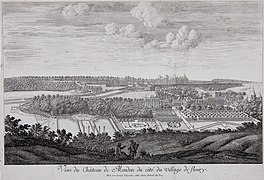
Vue du château de Meudon du côté du village de Fleury. (Fleury köyünden şato de Meudon'un görünümü), Israel Silvestre, 1688. Musée d'art et d'histoire de Meudon
Apoji: Louis XIV ve Monseigneur (1695-1711)



Prens eserleri


Grand Dauphin Meudon'da kapsamlı bir çalışma yaptı ve onu özel gösteri yerine dönüştürdü, bir milyon yüz kırk bin harcadı Fransız livres kral, babası onu kraliyet konutları arasına koymasına ve Bâtiments du Roi.[10] On altı yıldan fazla bir süredir, araziyi süslemek ve korumak için en az üç milyon lira harcandı, bu muazzam bir miktar. Prens daireleri beğenisine göre yeniden dekore etti. Dauphin, Meudon'un kendi sanatsal anlayışlarını ifade etmesine izin vererek, Louis XIV tarzının bazen pusulalı yönünü bozdu. İlk kez olmasa da, Meudon sistematik olarak "Capucine" ahşap işçiliği, yaldız desenli oymalı ve cilalı ahşap şeritleri kullandı. Regency stili kısmen Meudon'da ortaya çıktı. Dauphin, kralınkilerle rekabet etmeye çalışan zengin koleksiyonlarını orada topladı: akik vazolar, Hint kumaşları, Gobelin halılar, Çin porselen, büyük ustaların resimleri ve özellikle mücevher koleksiyonu. Bazı odaları birkaç kez yeniden dekore etmekte tereddüt etmedi, örneğin Charles de La Fosse ışık tarzını ifade etmek Claude Audran. Ana dairesi, Château-Vieux'un doğu kanadında zemin katın uzunluğundaydı. Ayrıca Château-Neuf'ta geçit töreni dairesi ve kestane ağacı kanadında "küçük, taze bir daire" vardı.
Dauphin, Meudon'da ailesi, arkadaşları ve fahişeler, özellikle Savoy'lu Marie-Adelaide Burgundy Düşesi Bourbon'lu Marie-Anne (1666-1739), gelini, Conti Prensesi ve Louise Francoise de Bourbon, Bourbon Düşesi, (1673-1743)]], iki üvey kız kardeşi, Louis-Antoine de Pardaillan de Gondrin D'Antin Madame de Montespan'ın oğlu. Ayrıca metresini de yerleştirdi. Marie-Émilie de Joly de Choin. Tıpkı babası gibi Marly Kalesi Dauphin, Meudon'da seçilmiş arkadaşları ile rahat ve sıcak bir atmosfer bulmayı severdi. Bu sayısız çevreyi barındırmak için Dauphin, kapsamlı eklemeler yaptı. 1702'de, Château-Vieux'deki alan kısa sürede yetersiz kaldı. Eski avlu olan kestane ağacının kanadına sahipti. ofisler, bir asma galeri ile şatoya bağlanacak şekilde yeniden düzenlendi. Zemin katta büyük bir resepsiyon salonu düzenledi. Ayrıca hala görülebilen yeni bir ortak alan inşa etti. Emanet etti Jules Hardouin-Mansart, tüm bu eserlerin mimarı, bir şapel yapımı. Antoine Coypel Dauphin'in gözde ressamlarından biri olan sunak resimlerini, anıtsal bir tablo olan "Diriliş" i ve boyutları çok daha küçük olan "Duyuru" yu resmetmiştir. Heykeller Noël Jouvenet, François Lespingola ve Jean Hardy.
1705'te, saray mensuplarını barındırmak için alan hala yetersizdi ve sayıları giderek artıyordu. Her an Monseigneur, yaşlanan Louis XIV'in ölümüyle Fransa'nın bir sonraki kralı olabilir. Dauphin daha sonra modası geçmiş mağarayı yıkmaya ve yeni bir kale inşa etmeye karar verdi. Château-Neuf . Jules Hardouin-Mansart ve Louis XIV, şapel ve Palais de Versailles müteahhitlerine emanet edilen projede işbirliği yaptı. Meudon'daki tüm işler gerçekten de Kral Binaları kurumu için çalışan kralın istihdam ettiği aynı sanatçılar tarafından yapıldı.
Château-Neuf beş seviyeye sahipti, ancak dik eğim nedeniyle, yan taraflarında aynı görünüme sahip değildi. parter ormanın kenarındaki gibi. Bina kanatları ile birbirine bağlanan sırt teraslı çatılarla taçlandırılmış üç pavyondan oluşuyordu. Komşu Château-Vieux'un mimari karakterini gölgelemeyecek olan bu ölçülü mimari, yine de yan pavyonlarda ve merkezdeki ince heykellerle zenginleştirildi. alınlıklar Dauphin'in armasını tutan melekler. İçeride, bir dizi daire büyük bir merkezi koridora açıldı. Dauphin'in koleksiyonlarını öne çıkaran iç dekorasyon, yaldızla zenginleştirilmiş patel renklerinde verniklenmiş veya boyanmış ahşap panellerden oluşuyordu. XIV.Louis, yeni inşaata rağmen Château-Vieux'daki olağan konaklamasını koruduğu için Monseigneur için bir tören dairesi planlandı. Château-Neuf tüm Avrupa'nın hayranlığıydı. Yaklaşık on yıl sonra, Antin Dükü -de Petit-Bourg kalesi Evry içinde.[11]

Monseigneur'un gelişinde 1695'te Château-Vieux'un zemin katının düzeni.
1700 yılında Château-Vieux'un zemin katının düzeni.
Meudon'daki Château-Vieux'un birinci katının düzeni, 1700
Château-Vieux'un 1702'den sonra şapel ile kesiti. Doğu-batı ekseni, 2013
Sağdaki Château-Vieux ve aile des marronniers (Kestane ağacı kanadı) diyagramı. ADY

Château-Neuf parter. Mariette, 1715 civarı.

Château-Neuf'un üçüncü katının şeması ("le Bel étage", güzel kat olarak bilinir) Mariette tarafından 1715 civarı
Asma bahçelerin zenginliği

The gardens were not to be outdone. Başlıklı şiir Maison royale de Meudon (Royal House of Meudon), dated 1703, even compared them to the Babil'in Asma Bahçeleri nın-nin Semiramis. To expand Meudon, the Dauphin in 1696 acquired the neighboring estate of Chaville. He thus formed a vast hunting preserve where he and his father, who also liked Meudon, practiced venery. The park of Meudon was thus linked to that of Versailles, and together they made up the Grand Parc de Versailles, extending from Meudon to Saint-Germain-en-Laye. Many embellishments are carried out in the gardens. Louis XIV took pleasure in advising his son on them. The King - or his son - even drew up a "Manière de montrer Meudon" a guide in the style of the texts written for Versailles.
The Arthelon waterfall, lower gaardens of Meudon. CA. 1700
one of the two waterfalls framing the "pièce de M. Le Nostre" (piece by Monsieur Le Nostre)[kaynak belirtilmeli ]
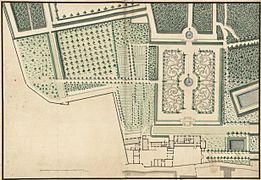
Plan for renovation of the parter of the Hôtel Courtin, lower gardens of Meudon, ca 1710. BNF

The park and the gardens of the château, Mariette, circa 1715

Overall map of the domains of Meudon and Chaville, by Alexandre Lemoine, ADY. 1723
18. yüzyıl

At the death of the Dauphin in 1711, the castle was still perfectly maintained, since the Bâtiments du Roi (King's Buildings) administered it. Nevertheless, until the death of Louis XIV, no member of the royal family returned to Meudon, as a result of the remarks made by Louis XIV the day after the death of Monseigneur his son, wishing that the new Dauphin, the Duke of Burgundy, make no more trips to Meudon. The Marquis de Sourches, on the 17th of April, 1711, notes that "Meudon was completely emptied and that all the furnishings were taken to the King's furniture storehouse."ref>Mémoires du marquis de Sourches, 17 avril 1711..
On 17 May 1717, the Tsar Büyük Peter eşliğinde Prince Rakoczy ve Marshal de Tessé visited Meudon and rode horseback in the gardens.[12]
On May 16, 1718, Madame de Ventadour organized a fireworks show for Louis XV, who visited Meudon two or three times a week all that summer. On the following June 6, a new fireworks display was mounted in honor of the king.
Duchess of Berry, daughter of the Regent (1718-1719)

Marie Louise Élisabeth d'Orléans, Duchess of Berry, eldest daughter of the Regent, owned the Château d'Amboise and wanted to swap it for Meudon. She was then the first lady of the court of France, and both cousin and aunt to the young unmarried king. The Regent eventually agreed to the exchange effective 30 October 1718. The Duchess of Berry, who was then pregnant, gave the management of this new residence to her paramour, the Count of Riom, lieutenant of her guards.[13] Riom took possession of the castle the next day, 31 October. But the governor in office, Hyacinthe de Gauréault Dumont nevertheless retained his salary. On 2 November 1718, the Duchess went to Meudon to choose her apartments. On 8 February and 24 March 1719, the Regent came to Meudon to have supper with his beloved daughter, by then just about to give birth.[14]
From April 12 to May 14, 1719, the duchess was convalescing at Meudon, hoping to recover from her harrowing delivery. She died on July 21, 1719, at her Château de la Muette in Paris, to she had travelled from Meudon.[15] On 22 July 1719, a few hours after her death, seals were affixed to her properties: the Luxembourg palace and her castles of La Muette and Meudon.
Saint-Simon (1719-1722)
After the death of his daughter, Naip made Meudon available in favor of Saint-Simon one of his principal advisers, a considerable honor. Thus, the famous memorialist could stay close to Saint-Cloud, where the Regent owned his family castle. On the night of June 15–16, 1722, the marriage of the daughter of Saint-Simon, Charlotte of Saint-Simon, with the Prince de Chimay was celebrated at the chateau. The blessing was given by the Abbé Languet de Gercy, parish priest of Saint-Sulpice.
Louis XV and his children


Le 27 septembre 1722, à la demande du jeune roi, le Maréchal de Villars vient à Meudon voir le fortin construit pour Louis XV, qui « lui parla souvent de son fort et le mena à toutes les attaques ». Rappelons que Louis XV était petit-fils de Monseigneur.

On the 17th of April, 1723, the King went to Meudon, went through the apartments of the Chateau, and gave some orders for the stay which his Majesty was to go there to do. Indeed, from 4 June to 13 August 1723, Louis XV, the "Infante Reine", the Naip and the Court settled in Meudon for a month, time enough to restore Versailles to house the young sovereigns. 10 Ağustos'ta, Cardinal William Dubois died at Versailles. "As soon as he was dead, the Duke of Orleans returned to Meudon to inform the King of this news, who begged him to take charge of all the conduct of affairs, declared him Prime Minister, and was sworn in on the following day" . Pierre-Denis Martin (1663-1742) painted for the king "A vision of Meudon in perspective that includes all the park and the castle, Monseigneur entering there."
On December 14, 1725, the new queen Marie Leszczynska, who married Louis XV on September 4, came to visit Meudon for the first time.
Finally, in September 1726, a royal edict brought together Meudon at the Crown Estate with the land that depended on it, with the exception of Chaville Castle and Park, and Castle and farm of Villacoublay. On this occasion, the arms of Le Tellier - azure, with three lizards of silver laid in pal, to the chief sewn Gules charged with three gold stars - which were still in place within the central pediment, are erased.
In May 1733, at Versailles, a scene was set up between Louis XV and the governor of the castle of Meudon: Marquis de Pellevé,
"Stay of the Children of France in Meudon in 1733.
The sojourn of the children of France at Meudon was decided at the beginning of May, 1733, in an assembly of doctors held in Versailles, with regard to their health, the death of Madame The Duke of Anjou having frightened the others.
Their journey was subsequently scheduled for the 21st of the same month and a few days before De Pellevé, Governor of this castle, speaking of their stay with M. le Cardinal de Fleury, told him that it would cause him some expense, and that he was persuaded that his Eminence wished And to treat him like his predecessor M. Hyacinthe de Gauréault Dumont had been there while the feu Roy remained there, and to grant him the same gratification.
The cardinal replied that the king's affairs were not in a position to make such graces, which did not prevent him from taking the time that the cardinal was with the king to speak to him in the presence of His Majesty and His Eminence told him the same thing.
He did not confine himself to these two rejections, he made the same request on the 21st, at the time when his Majesty was speaking to the duke Of Charot. The King replied that the matter was decided, which obliged him to cease. Only for a few moments: for he has again returned to the charge, and has represented to the King that he has interrupted a second time, the expense which he would be obliged to make, and the injustice which was done to him, His Majesty to tell the captain of his guards to take him out of his room. It was ordered to the officer of the guards who commanded Meudon not to let him enter the chamber of the Louis de France (1729-1765) or the ladies".
Queen's parents: the visit of Stanislas Leszczyński (1736-1737)

On 4 June 1736, Stanislas Leszczyński, after abdicating in April, temporarily settled in Meudon. "SM goes there at least once a week since the king and queen of Poland live there."[16] (Luynes Dükü ).
On September 30, 1736, King Stanislas secretly signed the Declaration of Meudon[17] under pressure from Louis XV and the Kardinal Fleury. According to the terms of the agreement, possession of the Bar Dükalığı would be "current" for the former Polish king and "possible" for Louis XV.
On January 18, 1737, Leszczyński handed the seals to the new Chancellor, who swore an oath to the King of Poland. The ceremony took place in the large vestibule of the Château Vieux, on the ground floor of the central pavilion. Tarafından boyama François-André Vincent of this ceremony, is from much later, since it dates only from 1778.
On March 31, 1737, "the king went today to Meudon bid farewell to the king and kraliçe Polonya. (Luynes Dükü ). They left Meudon the next day, April 1st. The two castles were then stripped of their furnishings.
In the summer of 1743, facing the threat of Charles Alexander, Queen Catherine of Poland, wife of Stanislas and mother of the French queen, took refuge in Meudon. Stanislas took refuge in Metz.

The Knight of Fréjus visited Meudon on May 5, 1748. He left the following description:" On the 5th of May 1748, the first Sunday of the month, I went to Meudon by galiot. We went up to Sèvres and from Sèvres we went upriver to the Capuchin monastery at Meudon, where we heard mass. The church there is not unusual, but their garden is very beautiful. From there we ascended the terrace of Meudon to the château, which is situated on a mountain from which all of Paris and the surrounding villages can be viewed. All the hills around Meudon are planted in vineyards and well maintained. The castle is superb. I noticed on the large door the arms of Louvois, and below the image of Louis XIV in metal. A gallery reigns in beauty outside the windows of this castle, as well as a facade on the side of the garden, charming. İsviçreli[açıklama gerekli ] then took me to the apartments, which are very beautiful, though less extensive than those of the Palace of Versailles. I saw two chambers lined in Gobelinler tapestry of admirable beauty.
Most rooms are covered in mirrors. The gallery leading to the chapel is superb. I saw there a very fine picture of the siege of Mannheim under Louis XIV, and a bust of Alexander of porfir which is inestimable. Another, of Aristo in Egyptian marble, is seen as a masterpiece. The chapel of the castle is very agreeable, with a single nef. There is only one altar, whose painting represents the resurrection of our Lord Jesus Christ, but it is one of the most beautiful pictures that can be seen, and is said to be of Raphael by Antoine Coypel. From the castle we were led to see the new apartment [the Château-Neuf] It is very lovely and very agreeable, but less handsome than the first. From the castles to the village which is at the foot of the mountain, one sees only parterres and gardens of a charming cleanliness and arrangement. We saw the orangeries, the greenhouses. They are far from being as beautiful as those of Versailles. From there we ascended by a superb staircase to the top of the mountain, where you find the most beautiful alleys of trees, with beautiful pools of water. Going through the woods on the side of Sèvres, you find a basin of prodigious expanse, at the top of the mountain, beside a green meadow with a very gracious view. The alleys and gardens of Meudon have no beautiful statues as at the park at Versailles. The castles themselves do not approach the richness of that of Versailles but the location of Meudon...provides a beautiful view...The stables there are not beautiful. After seeing all that there was to see, we were dined at Meudon in the village... For dinner for three, including me, I paid three Livres... [I] have not eaten elsewhere pigeons so fat (...)[18]
Château de Bellevue preferred after 1750
Bir yetişkin olarak, Louis XV tercih etti Château de Bellevue â that he had built for Madame de Pompadour. The castle was used to accommodate courtiers, and the castle stables are used to serve Bellevue, whose stables were very small.
View of Meudon from Fleury. Jacques Rigaud, ca. 1730-40
"Dessein de la décoration et du feu d'artifice tiré à Meudon" (Drawing of decorations and fireworks at Meudon) in honor of the Duke of Burgundy, 13 September 1756. AD 92.
West wing of the Château-Vieux de Meudon, 1773. Drawing by architect Louis Le Dreux de La Châtre
"Vue prise à Meudon" (View from Meudon): the stair of the Petit Pont. Late 18th century by Thiery de Sainte-Colombe, INHA
Louis XVI and Marie-Antoinette in Meudon
The new young king often liked to come and hunt in Meudon. One year after his accession, the architect Louis Le Dreux de la Châtre drew up an inventory dated October 10, 1775, which enumerates the "mirrors, marbles, paintings and other effects belonging to the King" in the castle. In the margin are drawn overall diagrams of all the mirrors.[19]
An edict of the king, in May 1778, united the domain of Meudon to that of Versailles, "to be governed and administered in the future in the same manner."
Louis XVI himself designed a pavilion called the "Trivaux Pavilion" in 1783, in an Anglo-Chinese style, which was finally corrected in a more French style by the architect Jean-François Heurtier. This pavilion was situated at the very top of the green carpet of Meudon, towards Meudon-la-Forêt. At Meudon Louis XVI ve onun eşi Marie-Antoinette lost little Louis-Joseph de France, who died on June 4, 1789, a month before the capture of the Bastille.
In 1791, the castle still served as a holiday home for the new Dauphin, as represented by a watercolor by Jean-Baptiste Isabey.
In his "Journal," on June 8, 1788, Marquis de Bombelles described Meudon:
"I accompanied the ladies to the ambassadors at the chateau de Meudon. The new castle, where we dined at the house of the Duke of Harcourt, was built by Monseigneur for Marie Émilie de Joly de Choin, his mistress. This castle is in a proportion which would render it suitable to every nobleman in a position to spend from 2 to 300,000 livres a year. It is not the same with the old castle. This palace, which M. de Louvois had enlarged, embellished with a magnificence as indecent as it is incredible, would still very easily be a truly royal residence. All the ceilings are painted in arabesque, as if the reigning taste had presided over their order. The cornices, the chimneys, the parquets of superb woodwork, nothing would need to be modernized. There is, in a turret, a cabinet painted also in arabesque on a background of gold, which is as fresh of paint as if it came from the hands of one of our best artists. It is a question of making this beautiful castle the home of all the summers, if we do not feel the sorrow of losing this prince."

Portresi Louis XVI 1786'da
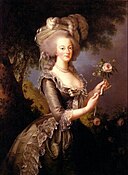
Portresi Marie-Antoinette, 1783
Pavillon de Trivaux, 1783
Death of the Dauphin in Meudon, 4 June 1789
Retour de la promenade de Mr le Dauphin (Louis XVII ) at the vieux château in Meudon, Jean-Baptiste Isabey, 1791. Musée du Louvre[20]
19th century: between pomp and decline
Sonra 10 Ağustos 1792, the fate of the castle became uncertain. Ulusal kongre quickly took care to remove most of the over-the-door paintings, carefully disassembled and transferred to provincial museums, which saved them from destruction.
"Castle of the Republic" (1793-1795)
On November 4, 1793, Pierre Choderlos de Laclos, appointed chief commissioner of experiments at Meudon, took possession on behalf of the Minister of Marine of this place, where he had suggested setting up an artillery and ammunition tests[21]
But Choderlos de Laclos stayed only one day in Meudon, since he was arrested the next day. The site was transformed by the Convention into a national facility for various tests. It would serve as a factory for aerostatlar and became the "castle of the Republic", which serves as a place of experimentation to arm the new regime. As such, the castle will be the object of an illumination paid by the public funds.
Nicolas-Jacques Conté was, together with several other scientists, in charge of these military and scientific experiments at Meudon, where he was given direction of the aerostation school established there. Conté had under his orders a confused gathering of young men in all professions, without any dye of chemistry, drawing, or mathematics, who were called upon to create an entirely new technique. Conté had to approach the elements of the different sciences, for this new teaching had to embrace everything: chemistry, physics, mechanics. Conté, by giving both theoretical and practical lessons, Conté had the models he gave, the instruments he imagined, executed by the hands of his pupils, spending his nights preparing drawings for his lessons, Experiences, sometimes dangerous.
- Fabrication of military aérostats at the château in Meudon. Watercolors on paper by Nicolas-Jacques Conté

Découpage des toiles pour composer des fuseaux (1/5) 
Assemblage des fuseaux (2/5) 
Préparation du vernis (3/5) 
Étalage du vernis et vérification des joints (4/5) 
Aérostat au campement sous sa tente de protection (5/5)
Château-Vieux fire and demolition

In 1795, a fire, linked to the technical research of the occupants, ravaged the chestnut tree wing and damaged the west wing of the Castle-Vieux. The castle remained in this condition nearly a decade. Many English visitors came to Meudon from 1802, and left several descriptions or drawings (for example the drawing of James Forbes). English colonel Henry Thornton Thornton, of Thornville-Royal, Yorkshire, describes the site in a letter written in English, dated August 31, 1802:
- The day before, M. Belanger had proposed to us an excursion to Meudon, a pretty park whose interior covered the walls of twenty miles, and which had been Designated as a more than desirable potential investment. A chair had been fixed on a most comfortable carriage, in view of this expedition. The castle of Meudon, originally residence of Madame de Pompadour [sic], consists of an immense block, unfortunately dilapidated. It nevertheless retains some traces of its past splendor. We were politely received by the concierge (or maybe he was the caretaker), whose manor was always likely to be converted into a pleasant one, in a beautiful park with a forest landscape covered with water jets and ponds. residence. This person led us to the castle, drawing our attention especially to the apartments of which the last occupant was none other than the unfortunate dauphin. I did not have time for further exploration of the park, but my guide informed me that it included farms, plains, etc., all within 500 acres, to which 10,000 acres of forest. He also told us that the walls were once partly collapsed, on the orders of the late king, in order to give the game the possibility of escape, but that these had since been repaired. He also pointed out that the estate comprised 29 water bodies of various sizes, leading me immediately to one of them, with a capacity of about 9 acres. The latter was walled and partly surrounded by a wooded landscape, but its shape offered, from a distance, a pleasant rendering. It was also necessary to take into account the presence of some fish, hares and rabbits, as well as a reasonable number of partridges on the estate. On the other hand, all the pheasants had been slaughtered. The whole of the castle, as I said before, is now in ruins, and to entirely shave it would entail considerable expense, the cement of these old buildings being particularly solid. But from the point of view of its extent and its proximity to the capital, Meudon would undoubtedly constitute a precious acquisition (...)
Ressam Hubert Robert, who was in charge of the landscaping of the gardens of Meudon under Louis XVI, comes to draw the demolition site in 1804. The Château-Vieux is destroyed from [1803]. In 1805, there is still a small part of the Château-Vieux (southwestern pavilion) as well as the chapel, as indicated by François Collet Duclos in his report of 3 Ventose 13 (February 22, 1805). The whole was the subject of excavation works until about 1808, after recovering some ornaments, including the stone columns nowadays located in the small rotunda of the Palais du Luxembourg (Senate), that the architect Jean Chalgrin was able to reuse.
Le Château-Vieux de Meudon en ruines, en 1802. James Forbes, Musée de l'Ile-de-France, Sceaux
La démolition du Château-Vieux de Meudon, tarafından Hubert Robert, 1804

Trois ouvriers déplacent une colonne du château de Meudon. Hubert Robert, circa 1804. Musées de Weimar, Schossmuseum, KK 9110
Démolition du Château-Vieux de Meudon, Hubert Robert, 1806. Getty Müzesi, Los Angeles (Amerika Birleşik Devletleri )
Schéma du Château-Vieux de Meudon en cours de démolition, 22 February 1805. En rose foncé, ce qu'il reste à démolir. ADY, 2Q 34
Columns from the château, taken to the rotonda of the Senate par Chalgrin
Napoleon : Meudon, Imperial Palace of the King of Rome (1807-1815)


After deciding in 1803 to demolish the Château-Vieux, which had been burnt down in 1795, and when he was only Bonaparte, Emperor Napoleon decided in 1807 to make the Château-Neuf an imperial palace. He restored the gardens and refurbished the Château-Neuf, notably by the architect Jean-Baptiste Lepère. A wing called the "Economat" was erected on the site of a part of the ruins of the chestnut tree wing. The Emperor, who wanted to make Meudon a "school of kings" in Europe, installed the Roma Kralı in 1811, under the responsibility of his governess, Louise Charlotte Françoise de Montesquiou. To this end, numerous orders have been made to furnish the palace of the Empire's heir (new Empire style decoration), furnishings, silks, etc.).
On April 22, 1811, Napolyon I visited Meudon. On June 30, 1811, Meudon was placed at the disposal of Letizia Bonaparte. In April 1812, the King of Rome came to stay at Meudon.During the summer, Queen of Westphalia, karısı Jerome Bonaparte, also stayed at Meudon, with Madame Mother. The Empress was said to have resided at the palace during the Russian campaign, although she was staying at Saint-Cloud. From March 24 to November 14, 1813, the Queen of Westphalia made another visit to Meudon.
But, at the fall of the Birinci İmparatorluk, the castle lost its status of Imperial Palace.
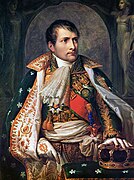
Napoleon I, as King of Italy, 1805
Projet d'aménagement of the terrace under Napolyon I, tarafından Jean-Baptiste Lepère, c 1808
Château de Meudon c. 1812, Birinci İmparatorluk

Distribution du troisième niveau du Château-Neuf sous Napoléon Ier, 1812
Fauteuils commandés par Napoléon I for Meudon, musée de Fontainebleau
Pendule de l'Étude ou de la Méditation, vers 1810, Mobilier National.
Feu en deux parties, c. 1810-1811, gilded bronze, Jean-Jacques Feuchère, Mobilier National
Guéridon, bois de frêne bronze doré et marbre blanc, Mobilier National
Console fournie par Maigret, bois de frêne et marbre blanc, Mobilier National
Écran à glace, bois de frêne, gilded bronze, mirror, Mobilier National
Lustre placé dans la Galerie du Château-Neuf, c. 1811, gilded bronze, Feuchère, Mobilier National
Feu de la galerie du Château Neuf de meudon, Mobilier National
Meudon under the Restoration and the Orleans


Louis Louis XVIII, Charles X ve Louis-Philippe used Meudon as a hunting ground near Versailles, eminent.
Charles Ferdinand, son of Charles X, went there to hunt between 1815 and 1820.
After his abdication of the Imperial throne of Brazil on April 7, 1831 Peter I of Brazil) returned to Europe and settled in France with the title of Duke of Braganza. In the autumn of 1831 he spent some time at the Château-Neuf, an estate the king Louis-Philippe freely put at his disposal. During his stay in France, he became a friend of the famous General La Fayette.
A stud[açıklama gerekli ] was then installed below the old gardens at the bottom of Meudon. The Prince of Orleans, under the July Monarchy, stayed there in 1834 and wrote his memoirs there. But he died accidentally in Neuilly-sur-Seine 1842'de.
Louis-Philippe also made available the castle of Meudon to Marshal Soult, who stayed there several times in summer.
On May 8, 1842, a railway catastrophe took place in Meudon, in which Jules Dumont d'Urville telef oldu. It was the first in France and one of the first in the world. Louis-Philippe I offered the Château-Neuf to treat survivors.
After the revolution of 1848, plans were made to make Meudon the new headquarters of the Ecole Polytechnique (Ecole Polytechnique). But these grandiose projects, one of which was established by the architect Hector-Martin Lefuel, in the end did not see the light of day.
Meudon, pris des murs du haras, par Bergeron. Vers 1825. BNF.
Détail d'une porcelaine de Sèvres représentant le Château-Neuf de Meudon sous Louis-Philippe. Musée de Fontainebleau, Galerie des Assiettes.
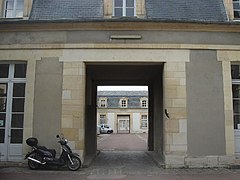
Les écuries du château de Meudon, conservées.
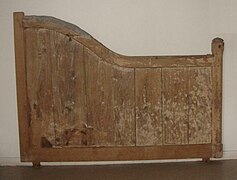
Stalle du XIXe siècle provenant des écuries du château.
Second Empire: the hideout of Prince Napoleon

Although Meudon was assigned to Prince Jerome's amcası Napolyon III, he did not visit the property. On the contrary, from 1860 to 1870, his son, Napoleon Bonaparte, cousin of the Emperor Napoleon III, often occupied Meudon. In Paris he owned the famous Pompeian house sheltering his connection with the actress Rachel Felix, but it was to Meudon that he cames to "sulk" the protocol at the imperial court, of which he was not fond. He brought his wife Marie-Clotilde of Savoy and her three children, Louis Bonaparte (1864-1932), Louis Victor and Marie Laetitia. He collected many species of plants and exotic animals, brought back from his travels abroad. Several large receptions were organized at the castle, such as the one in honor of Louis I, king of Portugal, in 1867.
Château-Neuf de Meudon c. 1860
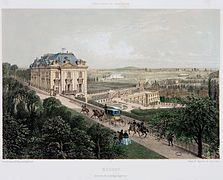
Meudon from the upper terrace. "Paris dans sa splendeur". Chapuis del.
İçin resepsiyon Portekiz Louis I veren Prince Napoléon, salon-serre of the Château-Neuf (former upper vesti
Meudon kennels and Prens Napolyon köpeği
1871 Château-Neuf fire and takeover by the Observatoire de Paris



Because the site is strategic, dominating Paris, a battery of Prussian artillery was installed there in 1870. The new castle caught fire on 31 January 1871 and burned for almost three days. Hypotheses on the cause included either a deliberate fire set by the Prussians as they left, or a bombardment by La Douai , a naval cannon, placed in bastion 74 of the Thiers precinct. The ruins were preserved for several years, until the site was entrusted to astronomer Jules Janssen in 1875. Janssen did not hesitate to raze nearly half the Château-Neuf, and together with architect Constant Moyaux, between 1880 and 1885 built there an astronomical observatory, later attached to the Paris Gözlemevi 1927'de.
Since then most of the estate (high preserved gardens) has been closed to the general public, and remains so to this day.
- Drawings and photographs, Château-Neuf ruins

The Château-Neuf after the fire of 31 January 1871

Photograph of the Château-Neuf after the fire, 1871. Private collection
View of Meudon after the war of 1871. Hubert Clerget, Musée Carnavalet
Photograph of the lower vestibule of the Château-Neuf after the 1871 fire
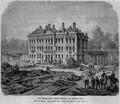
The ruins of Château-Neuf and surroundings, February 1871

The 20th century: a gradual renovation


Over the years, vegetation has encircled the Orangery, making it inaccessible. The destruction of the old village of Meudon after the war, and the reconstruction of the city center, has removed the once picturesque setting of multiple roofs at the foot of the old castle. The notion of heritage did not gain traction in French society until the 1970s and 1980. The entire estate is now registered as a historic monument, though this was done very late for such a historic site, while similar large estates in Ile-de-France had been declared historic well before.
The domain today
Although the Château-Vieux was destroyed, it still retains much of the splendor of the domain. In fact, 40% of the surface area of the original buildings, (the remains of the Château-Neuf, orangerie, communes, etc), still exists. One can still admire the avenue of the castle traced by Louvois, the guardhouses and common of the Grand Dauphin, the kennel of Louvois, the great prospect of Servien, the nymph and the orangery of Louis Le Vau, and one can imagine the terraced gardens below the observatory, as well as the pond of Chalais and the green carpet. And above all, the large terrace, the most impressive achievement, is perfectly preserved. The orangery of Meudon was completely restored in 2012.
Thanks to its exceptional location (Paris-Versailles, the most touristic area in France) and its panoramic view of Paris (one of the most spectacular in Ile-de-France), the site is a tourist and economic hub.
The domain today

Aerial view of the Orangery and the remains of the Château-Neuf converted to an observatory

Aerial view of the terrace with the avenue of the château, towards the north

Aerial view of the old stables of Meudon

Aerial view of the terrace at Meudon, with the Bel Air pond
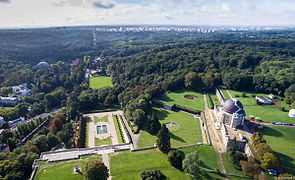
Aerial view of the Grande Perspective towards the south

Aerial view of Paris from Meudon
View of Paris from Meudon, 2013

The great dome of the observatory, built on the remains of the Château-Neuf
Les restes du Château-Neuf converted to an observatory. 2014
L'Orangerie de Meudon, 17th century, restored in 2012
View of the commons of the château, conserved today. 2009
The contreforts of the terrace of the old parterre of the château de Meudon, 2013

The high terrace today
The Grande Perspective at Meudon, condition in 2010

Bel Air pond today
Porte dauphine, 1703

Pond of Chalais, before the Grande Perspective, today.
Panoramic view of the Grande Terrasse at Meudon, 2013
Legal status: a split and partly inaccessible space

Today, the domain of Meudon is divided in two parts.
The lower part: The large terrace and the limonluk are managed by the Kent and are freely accessible to the public.
The upper part: The Observatory (Chateau-Neuf), the high gardens, as well as the communes situated at the entrance, come under the Ministry of National Education and are assigned to the Observatory of Paris. They are closed to the public.
The State still owns the entire estate, both the part assigned to the Observatory and that which is managed by the city government.
However, as regards the part of the domain accessible to the public, the State has signed a management agreement for the national domain of Meudon with the town of Meudon, which now manages it. Financially, the State still plays its role as owner and manages the pruning and maintenance work. It leaves it to the City to manage the site located within its territory.
The rehabilitation project of the Great Perspective

The project to reconstitute the Great Perspective of Meudon was launched as early as the 1980s, but has made little progress to date. Nevertheless, it continues, in consultation with the parties concerned. Indeed, three quarters of this major landscape axis of Ile-de-France, due to André Le Nôtre, are preserved. Only the part between the parterre of the orangery and the pond of Chalais remains blocked.

Archaeological potential

No excavation has ever been undertaken on the site of the Chateau-Vieux. However, the demolition records are formal: all the cellars and ditches remain under the current lawn. An archaeological campaign could make it possible to highlight this hidden heritage.
The only unknown parameter is the exact nature of the impact on the subsoil at the Château-Vieux right-of-way during the Prussian occupation in the Franco-Prussian War of 1870. Indeed, The Prussians occupied the whole terrace of Meudon, to bombard the capital and follow the operations.

Detail of the domain
Vieux-Chateau


The Château-Vieux was the central building of the estate, and the first historical castle at Meudon. It aligned with the Great Perspective.

Zemin kat

Büyük Vestibül ve Büyük Merdiven
Bu odalar ne zaman oluşturuldu Louis Le Vau kalenin merkezi köşkünü yeniden inşa etti Abel Servien 1655 ile 1658 arasında.
Küçük giriş, 1658-1803
Grand Escalier'in kesiti (büyük merdiven) 1658-1803
Büyük Vestibülün kesiti (büyük giriş), 1658-1803
Monseigneur "Büyük Daire"
Bu, Meudon'daki ana mesken oldu Louis, Büyük Dauphin (1661-1711), XIV.Louis'in oğlu, Château-Vieux'un doğu kanadının zemin katında. 18. yüzyıl boyunca bozulmadan korunmuştur.
1701'de başlayan son konfigürasyonunda, art arda şunlardan oluşuyordu:
- Bir koruma odası;
- Dört tuvalle canlandırılmış bir yemek odası Baküs;
- Mitolojik konularda dört oval tuvalle bezenmiş bir bilardo odası;
- Bir ön oda;
- 14 Nisan 1711'de çiçek hastalığından öldüğü dauphin'in yatak odası;
- Bir köşe dolabı;
- Capucine tarzında küçük bir ahşap gardıroptan;
- Küçük bir asma katın yanı sıra ağaçlık Capucine;
Muhafız odası

Blondel, kendi Françoise Mimarlık : "Muhafızlar Evi'nde, Kraliyet Evinde, Prens Muhafızlarının tutulduğu büyük bir oda olarak adlandırılır ve panellerin üzerine karabinalar takılıdır, Silahlarını uzatmak için; Ayrıca bu türlere yerleştirirler. Gardes du Corps'un gece dinlendiği yatakları gündüzleri üzerinde saydığı, altını aldığı masa çeşitleri olan davulları, geceleri Gardes du Corps'un istirahat ettiği yataklara yerleştirir.Bu odalar geniş, çok yüksek olmalıdır. büyük bacalar ve sadelikle dekore edilmiş. Versailles, Meudon, Chateau des Thuileries'e bakın ... ".
Dauphin'in yemek odası (1700'den itibaren)

1775 envanteri, 1700'lü yıllardan beri odanın "yaldızlı çerçevelerin ağaçlık yüksekliği, aynı korniş, yeşil mermer çan bacası ..." olduğunu göstermektedir. 1700'de Monseigneur, "bacchic" konuları resmetmeleri için dört farklı ressamı görevlendirdi. Aynı sanatçılar daha sonra salonun büyük salonunu süslediler. Chateau de Marly.
- Tarafından Charles de La Fosse (1636-1716): Bacchus'un zaferi, bir fil üzerinde Tyrsus sağ elinde, etrafında aletler taşıyan birkaç Bakire. Ön planda biri kaplana monte edilmiş iki çocuk, solda ise arka tarafta Silenus görülüyor. (Louvre Müzesi, INV No. 4537).
- Tarafından Jean Jouvenet (1644-1717): Bacchus'un doğuşu Perileri ellerine teslim ettikten sonra uçan Merkür. Bu efsane ile ilgilidir Semele Jüpiter'in çok sevdiği ve talihsizliğini Juno'nun yıldırımdan aldığı annesi.
- Tarafından Bon Boullogne (1649-1717): Venüs, Bacchus ve Ceres"Sevgili Venüs'ün soğuması olmadan Horace'tan bir pasaj; Resmin solunda bir Flora'nın tuttuğu bir bardağa bir üzüm üzümünü sıkıştıran Baccus; Onun yanında, ona bakan bir Ceres Altta, bir kafesin altında giyinmiş bir büfe var; Resmin ortasında, aşağıda içki içmek isteyen iki küçük çocuk var, bir kaplanın üzerinde yatıyorlar. " "Bacchus ve Ariane" olarak adlandırılan Louvre Müzesi. Aynı zamanda eski envanterlerde Bacchus ve Ariane, Bacchus ve Erigone veya Bacchus, Flora ve Ceres olarak da adlandırılır. II. Yılın sonunda Merkez Müzeye gönderilmiş, sıfatını kaybetmiş ancak Fransız okulunun anonim üyeleri arasında bulunduğu Louvre'da kalmıştı (Env. 8608). Restore edilecek.
- Tarafından Antoine Coypel (1661-1722): Silenus perisi Eglé tarafından böğürtlenle lekelenmiş. Tema, Virgil'in "Eclogues" adlı 6 numaralı bölümünün "Silenus" adlı bölümünden alınmıştır ve burada Virgil şunları yazmıştır: "Ve yaşlı adam gözlerini açarken, alnını ve böğürtlenin Kanlı suyunun tapınaklarını kızartır. " Her zamanki içkisinin ardından bir mağarada uyuyan Silenus, iki satir ve adına şarkı söylemeye söz verdiği perisi Egle tarafından şaşırır. İki satir, sarmaşık saplarıyla bağladıkları Silenus'u yakalarken, güzel Egle, sözünü yerine getirme tehdidinden kurtulmak için ezdiği böğürtlenlerle yüzünü kızardı. Ölçümler: 4 fit 9 inç x 4 fit 1 inç. Resim on dokuzuncu yüzyılda büyük ölçüde kesildi. Reims Güzel Sanatlar Müzesi, INV'de korunmaktadır. D.872. 2. 5.
- 18. yüzyılda Meudon'daki Monseigneur'un yemek salonundaki resimler
Silène, su perisi Eglé, Antoine Coypel tarafından dutla lekelenmiştir. 1701. Musée des Beaux-Arts de Reims.
Bacchus'un zaferi, Charles de la Fosse, 1701. Louvre Müzesi.
Bacchus'un doğumu, Jean Jouvenet, 1701. Özel koleksiyon
Vénus, Bacchus ve Ceres, Bon Boullogne, 1701. Louvre Müzesi.
Bilardo salonu
1700'den itibaren Louvois ve Jules Hardouin-Mansart'ın eski merdivenleri, "Salon du Billard" da dahil olmak üzere bir dizi oda yaratmaya mahkum edildi. 1775 tarihli envanter, odanın "yaldızlı çerçeveli, yaldızlı kornişli, gryot mermer bacalı yüksek ağaçlıklı" olduğunu göstermektedir. Monseigneur bu oda için aynı boyutta ve oval formda kapıların üzerine bir dizi resim sipariş etti. Hakkında:
- Nereden Charles de La Fosse: Vice ve Fazilet Arasındaki Herkül; "Çocuğun kalkan taktığı Minerva tarafından temsil edilen Bilgelik resmin tepesinde, soldaki Hafıza tapınağı Herkül'ü gösteriyor. Yükseklik 4ft 10 inç; L. 3ft 5 inç; oval. Kapının üstü. Bilardo odası Bu eserin icrası için Charles de La Fosse, "Herkül'ü temsilen Meudon'da yaptığı resim için 800 livre kusursuz ödeme için" iki kez, 1700'de 600 livre ve 1701'de 200 livre ödendi (CBR t IV col 1700 yılında boyanmış olan resim, 3 fit 10 inç2 x 3 fit 5 inç formatındaydı. Villot, Meudon'un resmini 1872'de Nevers müzesinde, şimdi dikdörtgen olan bir tuvalle doğru bir şekilde tanımladı (Invitation Villot, n ° 4538, 1m 20 x 1m 09).
Nereden Jean Jouvenet: Latone ve Likya köylüleri, "Latone, iki oğluyla birlikte yalvararak görünmeyi reddeden, kollarını yukarı kaldıran, onları kurbağalara dönüştüren Jüpiter'i çağıran Likya köylülerinden su isteyen Latone; manzaranın dibinde bataklığın kenarından geçen bir inek sürüsü görünüyor. "Bu eserin bir kopyası, Fontainebleau kalesinde şüphesiz orijinal olan Meudon Sanat ve Tarih Müzesi'nde (IV col 675). Versailles Sarayı'nın bahçelerinde bulunan Latona çeşmesinin merkezi beyaz mermer heykelinden doğrudan esinlenmiştir.
- Nereden Louis de Boullogne genç adam: Cephale ve Procris kocasına dart veren; Sol kolu uzatılmış ve eli okşadığı bir köpeğe dayanıyor; Resmin üst kısmında kızlık zarının meşalesini taşıyan aşk tanrısı görülmektedir. ". Compiegne'e (8676) yatırıldıktan sonra, tablo 1962'de Musée de Saint-Etienne'e şu adla gönderildi: Venüs ve Adonis ve yanlışlıkla Bon Boullogne'a atfedilmiştir. Eski oval şekli açıkça görülebilir. Resim 1700'de yapıldı ve pozlandı. David ve Abigail aynı ressam tarafından yaptırılmıştır. Louvre'daki Cabinet des Arts Graphiques'te bir hazırlık çizimi yapılır (Env. 24961).
- Antoine Coypel], sonra dördünün en genç ressamı: Herkül Alceste'yi yeraltından geri getiriyor; Yükseklik 3 fit 10 inç; Genişlik 3 fit. Antoine Coypel'in kendisi tarafından Meudon'a getirilen bir resim olan "Herkül'ün Yeraltı Dünyasından geri getirdiği karısı Alceste'ye dönen Admetus'a" sorusudur. (CBR t IV sütun 675). F. Engerand'ın (Kraliyet Tabletleri Envanterleri, Paris, 1899, s. Charles-Antoine Coypel, ressamın oğlu) anısına göre, resim Mayıs 1700'den önce yerleştirildi, bu edebi konuların yeniliğini gösterdi. Meudon'un resmi, Antoine Coypel'in çevirisi Mben mi Dacier, trajedisinin beşinci perdesi Euripides. Resim, Cholet Sanat ve Tarih Müzesi, Cholet Sanat ve Tarih Müzesi'nde korunmaktadır. Eserin adı "Herkül Theseus'u Taşıyor"! Mayıs 1700'de Antoine Coypel, işi zor tamamlanmış olarak kurmak için Meudon'a geldi.
- 18. yüzyıl boyunca Meudon'daki Monseigneur'un bilardo salonundaki dört oval tuval
Latone et les paysans de Lycie, Jean Jouvenet, Meudon'daki Musée d'art et d'histoire
Hercule entre la Volupté et la Vertu (Voluptuousness and Erdem Arasındaki Herkül), Charles de La Fosse, musée de Nevers
Herkül Alceste'yi Cehennemden Çıkarıyor, Antoine Coypel, Musée d'art et d'histoire de Cholet
Céphale et Procris, Louis de Boullogne le Jeune, Musée des Beaux-Arts de Saint-Étienne.
Antechamber (1695'ten 1699'a kadar Dauphin'in eski yemek odası)

1695 yılında bu işlevi gören eski "Monseigneur yemek odası", dairenin genişlemesi ile gerçek bir ön oda haline geldi. 1775 envanterinde şunlar belirtilmektedir: "İki pencere ile aydınlatılmış oda, altın çerçeveli lambri, yaldızlı korniş, yaldızlı arabesk tavan ve Audran. Jacques-François Blondel Meudon'un bu arabesk tavanlarına olan hayranlığını hatırlıyor, ancak tavanın tarzını bir prensin konutunu dekore etmek için kınamasına rağmen:
«D'ailleurs l'on peut réduire ces ouvrages à des nuages avec des Génies ve à quelques belle grisaille qui en forme les extrémités; dekor préférable à ces riches, mais peu vraisemblables peintures grotesques, dont on voit d'ingénieux desseins d'Audran ve qui sont exécutées avec un succès étonnant dans quelques appartements de Meudon, aussi du les l que les lambris & plafonds la Ménagerie: seul bâtiment of ce genre de peinture soit toplanabilir ».
1775 envanterinde ayrıca "yeşil Campan mermer bacası, her yükseklikte mermerle süslenmiş şöminenin tepesi, altın-bronz süslemeli altın-bronz süslemeler, iki parçalı ayna, ilk 52 inç genişliğinde 96 inç" olduğunu ekliyor. yüksek, ikinci 52 inç idem 26 inç yüksekliğinde, Batiste Fontenay tarafından boyanmış, meyve ve çiçekleri temsil eden, 3 fit 6 inç genişliğinde ve 2 fit 9 inç yüksekliğindeki kapıların üzerinde iki masa. "
Bu antre deuphin, 1693'te Louis XIV'e sunulan resim koleksiyonunu André Le Nôtre ve kral oğlunun emrine verdi. Bu eserler artık şurada korunmaktadır: Louvre müzesi.
Grand Dauphin'in yatak odası

1775 envanteri, Dauphin odasının şunlara sahip olduğunu göstermektedir: "Yaldızlı çerçevelerden oluşan duvar panelleri, yaldızlı korniş, yaldızlı tavan ve arabesklerle boyanmış Claude Audran III mermer serancolin şöminesi, üstü menekşe kahverengi mermerden, tamamı altın altın yaldız ile süslenmiştir. (...) Batiste tarafından boyanmış meyveleri temsil eden 3 fit 5 inç x 4 fit 1 inç genişliğindeki kapıların üzerinde iki resim. Monseigneur 14 Nisan 1711'de bu odada öldü. Bu baca araştırmacıların merakını uyandırdı. : Versailles'da korunan ünlü küçük resim, "Chartres Dükü ile yaptığı çalışma kabinesinde Regent'i" temsil eden Fiske Kimball'un Meudon'daki Dauphin'i temsil ettiğini. Elbette, orada bir kişi, orayı süsleyebilecek mobilya ve dekorasyon türlerini bulur. ama Jerome de La Gorce doğru soruyu sorar:
"Bu iç gerçekten var mıydı? Kapının solundaki paneller ile masanın bacasının, yani dekorasyon unsurlarının çoğunun Berain'in oymalı işinde aynı olması şaşırtıcı değil mi? kariyeri hala belirsiz olan ressam, temsil ettiği kişilere yakışır bir çerçeve oluşturmak için ressam tarafından yayınlanan plakalara başvurmamış değil mi? 1695 yılında tacın mobilyalarının envanteri: "[n ° ] 1615 - Kırmızı ve sarı saten kadifeden, işlemeli ve gümüş astarlı, 783 numaradan önce listelenmiş, Meudon'da Monseigneur le Dauphin'e hizmet etmek için yükseltilmiş ve döşenmiş, şimdi tam bir yatak, dört koltuktan oluşan bir döşeme, sekiz katlanır koltuk, iki bölme, iki kapı, altı perde, bir iş koltuğu ve iki duvar halısı ".
Buna ek olarak, Monseigneur odasına, Godron'dan satın aldığı bakır ve kaplumbağa kabuğu ile kaplı küçük abanoz masayı aldı, sekiz bronz karatidle desteklenen bir platosu vardı ve kakminin ortasında bir parmak otu üzerinde bir aşk tanrısı vardı. Bu masanın yanı sıra odada bir masa ve tabletleri figürler ve kuşlarla Çin groteskleriyle süslenmiş iki kaide vardı.

Köşe Dolabı


1775 envanterinde odanın "Büyük altın çerçeveli duvar panoları, altın kornişler, Audran tarafından boyanmış arabesklerle yaldızlı tavan. Menekşe breş mermerinden bacası, üst kısmı çok zengin bronzlarla süslenmiş tüm yükseklikleri mermerle süslenmiştir. çocuklar ve süs eşyaları altın altın yaldız (...) Önceki iki odada olduğu gibi, Audran tavanı arabesklerle süsledi: "22 Nisan 1699'da Meudon'a gelen kral, 24'ünde ayrıldı; İki gün sonra, 25 Nisan'da Mansart, Monsignor'dan köşe dolabının tavanının resimlerinin silinmesi, üç kat beyazla basılması ve odanın odasına benzer bir Grotesk boyama emri aldı. Dauphin. "Daha sonra silinen tavan, ancak konusu Louvois için Charles de La Fosse tarafından gerçekleştirilebilir. Pandoreve modeli Clémentine Gustin-Gomez tarafından tanımlanmış olan. 1702'de şöyle bulundu: "Monseigneur'ün Büyük Kabininde: Beş Porselen, 630 Louis; İki Bronz 180 Louis. Stéphane Castelluccio bu iki bronzun Laocoon ve Lutteurs, Monseigneur kesinlikle zengin "kakmacılık ayaklarını" buyurmuştu. Son olarak, kraliyet mobilyalarının envanterinde (Tome II, s. 434, 1697) şu numaranın altında belirtilmektedir: "1768 - Dolap pencereleri için, çeşitli renklerde ipliklerle iki yün ipliği ile şeritlenmiş dört rahat paspas Meudon'da Monseigneur. "
Büyük Dauphin'in ölümünü anlatan Saint-Simon, bize 14 Nisan 1711 akşamı bu odada, geliş ve gidişlerin ünlü sahnesinin "Kabine" Köşesi arasında geçtiğini söyler. ve Monseigneur'un ölmekte olduğu bitişik oda:
"Odaya girmek üzereyken, masanın bu kadar kısa aralığında Monseigneur'lere koşmak için vakti olan Conti Prensesi, odaya girmesini engellemek için kendini gösterdi. Hatta onu itip uzaklaştırdı ve ona artık kendisinden başka bir şey düşünmemesi gerektiğini söyledi ve kral, neredeyse o kadar ani bir güçsüzlük içinde ve bir tersine çevirmeyi tamamlayarak, girdiği dolabın kapısının girişindeki bir kanepeye geçmesine izin verdi. Odaya teslim oldu. Çıkan her şeyi haber istedi ve neredeyse hiç kimse cevap vermeye cesaret edemedi. Madame de Maintenon, krala koşarak aynı kanepeye oturdu ve ağlamaya çalıştı. Avluda arabaları zaten hazır olan kral, ancak Monseigneur'un süresinin dolduğunu anlamasının bir yolu yoktu. Bu bilinçsiz ıstırap, kralın dolaba girmesinden yaklaşık bir saat sonra sürdü. Düşes ve Prenses de Conti ikiye ayrıldı. ölen adam ve akrabaların bakımı arasında Şaşkın Fakülte, perişan uşaklar, vızıldayan fahişe sık sık döndükleri sırada yer değiştirmeden birbirlerini itti ve yürüdü. "

1699'da dauphin tarafından silinen köşe dolabının tavanının şeması

Altın zemin üzerine Arabesk, Claude Audran III tarafından, yaklaşık 1700. Archives des Arts décoratifs de Paris, env. 5482 A.Ménagerie de Versailles veya Dauphin'in Meudon'daki dairesi için

Audran'ın diğer dekorları, env. 5482 B
Dük ve Burgundy Düşesi denilen apartman dairesi
Grand Vestibule ile Monseigneur'un dairesi arasındaydı.
Bu odalar ana apartman dairesiydi Abel Servien 1659'da orada zemin kattaki odasında ölen.
Ne zaman Monseigneur 1695'te Meudon'a yerleşti, bu konutu, kendi evinin yanında, 1701'deki ölümüne kadar orada kalan Orleanslı Philip'e (1640-1701) verdi. Konut daha sonra Dük ve Burgundy Düşesi tarafından ölümüne kadar işgal edildi 1712'de.
Zemin kattaki odalar

Birinci katta, çoğunlukla "Salon des Moures" ve galeri olmak üzere geniş resepsiyon odaları bulunuyordu.
Salon des Maures


Abel Servien bu oval odayı yarattı, kalenin en önemli parçası. parter. Bu salon, buradaki salonla aynı zamanda inşa edildi. Château de Vaux-le-Vicomte için inşa edildi Nicolas Fouquet boyut olarak biraz daha küçük olmasına rağmen benzerdir. kubbe hiçbir boyalı dekorasyon almadı. Gabriel Blanchard on iki Grisailles 1733 envanterinin tarif ettiği kornişin altında: "Aynı salonda, yılın on iki ayını temsil eden" çocuklar, damoiselettir [sahte, Gabriel Blanchard] ve yapılamaz. yeri iki fit yüksekliğinde, 6 fit 5 inç genişliğinde, tüm maroufles olarak yükseltin.
Louvois, bu salona Mağribi ve Mağribi mermeriyle on iki dönem yerleştirildi, bunlardan sekizi Compiegne Sarayı'nda, 18. yüzyılın sonunda oraya transfer edildi. Bakan ayrıca tavan arasını yedi çiçek resmiyle süsledi. Jean-Baptiste Monnoyer. Meudon'un 1733 resim envanteri bunları şöyle açıklıyor:
1. "Her türlü çiçekle dolu altın bir vazo, altınla işlenmiş mavi bir halıya serilmiş - resmin alt kısmı bir gökyüzü." 2. "Kulpları altın olan, her türlü çiçekle dolu, arkasında altın işlemeli bir halı, biri mavi diğeri sarı iki papağan olan altın bir vazo ya da agatik bir tavır." 3. "Her türlü çiçekle dolu altın süslemeli bir goderon vazo - işlemeli altın arkasında kırmızı ve yeşil bir papağan olan bir halı" .4. "altınla işlenmiş kırmızı bir halı üzerine yerleştirilmiş her tür çiçekle dolu gümüş kase şeklinde bir vazo ve kasede bir tavus kuşu." 5. "Her türlü çiçekle süslenmiş altın bir vazo, bir gelincik yapraklarından biri vazonun koyulduğu kaide üzerine düşer." 6. "Her tür çiçekle dolu ayakla dolu bir yola yerleştirilmiş altın bir vazo ve vazonun arkasında bir tavus kuşu." 7. "Mavi ve altın rengi bir halıya yerleştirilmiş altın ve gümüş bir vazo, astarı kıpkırmızı bir balık tutan bir maymunla."
- Les termes en marbre de maures et de mauresques, Salon des Maures de Meudon. Aujourd'hui au palais de Compiègne.

Terme féminin, C38.120 MR 2494.
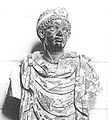
Terme masculin, C38.98 MR 2492.

Terme féminin, C38.129 MR 2495.

Terme masculin, C38.122 MR 2497.
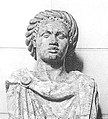
Terme masculin, C38.97 MR 2496.

Terme masculin, C38.121 MR 2493.
Giriş odası oyunlar olarak adlandırılır

Salon des Maures'den sonra, Versailles'da olduğu gibi, bir dizi karşılama odası, oyunlar için ve olduğu gibi, sözde "apartman" akşamları için hizmet verdi. Oval salondan sonraki ilk oda kare şeklindeydi ve çukurun kenarında iki pencere vardı. Dauphin Monseigneur, babasını memnun etmek için duvara Kralın Tarihinin duvar halısını astı.
Oyun odası
İkinci oda birincisine benziyordu ve aynı zamanda perdelerle zenginleştirildi, kuzey koyları bu amaçla tıkandı.

Salon du Petit Pont

Bu köşe odası, galeriyi çevreleyen iki salondan biriydi. Doğrudan yüksek bahçelere açılan "Petit Pont" a (küçük köprü) erişimi vardı. İskender'in porfir büstü oraya yerleştirildi.
Eski kale galerisi


Meudon galerisi 300 m² alana sahipti ve ana oda 40 metre uzunluğundaydı. Kuzeyde Salon du Petit Pont ve Salon des Albane olmak üzere iki oturma odası vardı.

- Meudon'daki galeri için Van der Meulen tuvalleri

La prize d'Ypres

La prize de Fribourg

La prize de Condé
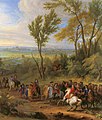
La prize de Lau
- Monseigneur altında galerinin nişlerine yerleştirilen dört heykel

La Fidélité (Sadakat), bir çizimin ardından Pierre Mignard, Jardins de Versailles

La Fourberie, bir çizimi takiben Pierre Mignard, Jardins de Versailles

Aurora veya gün doğumu, tarafından Gaspard Marsy, bir çizimi takiben Charles Le Brun, Jardins de Versailles.

Flore, tarafından Philippe Buyster (1595-1688)
- Meudon'daki galeriye yerleştirilen heykeller ve mobilyalar

İskender Mazarin. Louvre Müzesi
Ressam Raphaël'in büstü, Alessandro Rondoni
Alessandro Rondoni tarafından Annibal Carrache Bust

Jüpiter ve Junon, bronzlar Algarde. Wallace Koleksiyonu, Londra
Galeriye yerleştirilmiş sekizgen pedallar. Chaalis Manastırı

Albane salonu

Bu oda galeriyi sona erdirir ve Salon du Petit Pont'un simetriye sahip kolyesidir. Salon, ressamın adını taşıyor Francesco Albani köşelere birkaç oval şekilli tuval yerleştirildiği için, kopyalar ustanın çalışmasından yeniden yorumlandı. Aynalarla bezenmiş nişleri ve kubbeli tavanıyla odanın mimarisi, Versailles'daki Louis XIV Madalyaları Kabinesi'nden ilham almıştır.
Dauphin, oraya L'Algarde'nin muhteşem bronzlarını yerleştirecek, Jüpiter ve Juno.
Daire Louis XIV diyor

19. yüzyılın sonunda, Louis XIV'in dairesi, bir ön oda, bir kraliyet odası, arkaya doğru küçük bir geçit, "Kralın aynalarından oluşan bir dolap" ve manzaraya hayranlık uyandıran bir balkona sahipti. Paris.
Konsey ön odası

Ahşap işçiliği olmayan bu odanın zemin tarafında üç pencere ve avlu tarafında balkona erişim sağlayan iki Fransız penceresi vardı. Şömine rafı Kampaniyen yeşili mermerdendi.
Meudon'da Louis XIV'in yatak odası

Kral odasındaki şöminenin üstünde Andrea del Sarto'nun "Hayırseverlik" adlı orijinali ve ardından bu resmin bir kopyası asılıydı. Bu çalışma, kraliyet gücünün aktarımının bir alegorisi olarak yorumlanabilir.
Kralın aynalarının dolabı
- Le Cabinet des Glaces du Roi, yaklaşık 1697 - 1793. Arşivler nationales, O1 1768 A 1 ve 2.
Elévation de la paroi Nord.
Elévation de la paroi Est.
Elévation de la paroi Sud.
Elévation de la paroi Ouest.
Restitution 3D du Cabinet des glaces de Louis XIV, Franck Devedjian & Hervé Grégoire, Ocak 2013.
Madame de Maintenon Dairesi

Madame de Maintenon'un doğu kanadının ortasında bir antre, bir yatak odası ve bir dolaptan oluşan dairesi, Paris manzaralı bir balkondan yararlandı. Maintenon'un kabininde, kapının üstünde, özellikle David ve Abigail'in Louis de Boullogne tablosu vardı.

M Antechamberben mi de Maintenon, c. 1700

Mme de Maintenon Odası, 1700-1711

M Kabiniben mi de Maintenon, c. 1700
Conti Prensesi Dairesi


Daha sonra Conti Prensesi'nin dairesi onu takip etti ve başka bir "Cabinet des mirroirs" ile sona erdi.
Prenses odasında iki resim vardı Antoine Coypel, Psyche, Sleeping Love'ı keşfet, ve Aşk tarafından terk edilmiş ruh
Bitişikteki kabine de aynı ressam tarafından "Venüs Limni Ocaklarında" adlı tablo yerleştirildi. Bu üç eser, Monseigneur dairesi için üvey kız kardeş.
- Conti Prensesi'nin dairesindeki tuvaller Antoine Coypel, 1701

Psyché découvrant l'Amour endormi, Antoine Coypel, 1701

Ruh Terkedilmiş Antoine Coypel, 1701

Vénus aux forges de Lemnos, Antoine Coypel. 1701
Şapel

Şapel, 1702 yılının sonunda, Jules Hardouin-Mansart. Monseigneur tarafından arzulanan bu yapı, Louis XIV tarafından hedeflenmiştir. Bu şapel, Versailles Şatosu'ndaki Kraliyet Şapeli ve Versailles Kraliyet Şapeli ile aynı modeli takip ediyor. Ancak Meudon şapeli, Versailles'ınkinden on yıl önce tamamlandı. İkincisi gibi, tapınağın yukarısında bir çıkmazda biten beşik tonozlu bir nef vardır. Yüksek sunağın üstünde büyük bir resim var Antoine Coypel, dört metre yüksekliğinde, seksen beşe üç genişliğinde, "Diriliş" özelliğine sahiptir. Charles de La Fosse Versailles kraliyet şapelinin fırın fırınının resmini yapmak için bu kompozisyonu modelleyecektir. Coypel'in bir başka resmi, Duyuru, seti tamamlar.
Kürenin üzerine oyulmuş silahlar, şapeli yansıtan çizimdeki kraliyet silahlarıdır, ancak sonunda silah modeline göre gerçekleştirilecektir. delphinales. Mimari teorisyen, Jacques-François Blondel, örnek olarak, Châteaux de Sceaux ve Clagny "Mükemmel modeller".
1805 ile 1808 arasında imha edilecek.
Château de Meudon şapelinin Coupe de la tribune, 1701
Meudon şapelinin projet non définitif de coupe. Dessin de Jules Hardouin-Mansart, 1701. AN.
1775-1780 dolaylarında, Meudon şapelinin définitifini planlayın. AN
Meudon şatosunun şapelinin içini temsil eden Jeton, tribünden görünüşü, 1703. Özel koleksiyon
Kopyası Diriliş Yazan: Antoine Coypel, Vernon Şapeli
L'Annonciation, yazan Antoine Coypel. Estampe de Drevet
Kestane Ağacı Kanadı

Eski "Cour des Offices" veya "Basse Cour", Monseigneur lüks tören odaları yaratmak. Ek binanın tamamı daha sonra "Marronniers Kanadı" adını aldı. Geniş resepsiyon odaları, Terrasse des Marronniers'in genişliğini artırır. Dauphin'in metreslerini alması için bu büyük odaların arkasında küçük, lüks bir daire, "Küçük Taze Daire" de düzenlendi.
Küçük asılı galeri

Bu galeri, onu dik olarak takip eden iletişim galerisine bağlanır. Fontenay tarafından boyanmış büyük bir büfe, küçük asma galerinin perspektifini tamamlıyor.
İletişim galerisi
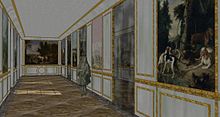
Bu oda büyük resimlerle dekore edilmiştir. François Desportes, oda için görevlendirildi ve ressamın başarısını sağlayacak.

İletişim galerisi, Kestane ağacı kanadı, yak. 1703. Franck Devedjian tarafından yeniden yapılanma, 2012
- François Desportes iletişim galerisi için görevlendirilen tuvaller, 1703
Un cerf poursuivi par des chiens (Köpekler Tarafından Takip Edilen Stag), François Desportes, 1703

La mort d'un chevreuil (Bir geyiğin ölümü), François Desportes, 1703

La meute de Monseigneur (Monseigneur'un Köpekleri), 1703, Musée de Gien
La mort du loup (Kurtun ölümü), François Desportes, 1703

Un sanglier chassé par huit chiens (Sekiz Köpek Tarafından Kovalanan Yaban Domuzu), François Desportes. 1703
Büyük oval dolap "


Bon Boullogne tarafından "Bacchus'un Zaferi" nin asılı olduğu "Salon doré" (altın salon) olarak da bilinir. Resim kayboldu, ancak Albertina'da (Viyana) korunan ve kardeşi Louis'e atfedilen bir hazırlık resmi, bu eserin kompozisyonunun neye benzeyebileceğini anlamamızı sağlıyor.
Geniş köşe dolabı

Bu odada dauphin'in bazı prestijli resimleri vardı. Renaud ve Armide tarafından Dominiquin, ve Musa sulardan kurtardı Nicolas Poussin tarafından. Bu tuvaller kraliyet koleksiyonlarından geliyor.
Büyük Salon
100 m² alana sahip kestane ağaçlarının bulunduğu dairenin ana odasıydı. Dauphin oraya kraliyet koleksiyonlarından iki resim de dahil olmak üzere başka resimler yerleştirdi. Paul Veronese.


Essai de restitution de la coupe de la paroi Est du grand salon des marronniers, yaklaşık 1705

Essai de restitution de la coupe de la paroi Sud du grand salon des marronniers, 1705 civarı. Dauphin Monseigneur tarafından yerleştirilen tablolarla.

Essai de restitution de la coupe de la paroi Ouest du grand salon des marronniers, yaklaşık 1705
- Tarafından tuvaller Nicolas Loir Kraliçe'nin Versay'daki dairesinden, Büyük Salon'da yeniden tasarlandı.
Pithopolis faisant servir des mets en veya au roi Pithès (Kral Pithès'in altın yemek servis ettiği Pithopolis), Nicolas Loir, eski adı "Cléopâtre qui, dans un festin ....", musée de Brou.
Reine donnant seyirci à un vieillard (Kraliçe Yaşlı Bir Adama Seyirci Veren), Nicolas Loir, aynı zamanda La reine de Saba (Saba Kraliçesi), Musée Hyacinthe-Rigaud, Perpignan
Reine s'adressant à des soldats (Dueen askerlere hitap ediyor) veya "la reine de Saba appuyée sur son trône" (Saba Kraliçesi tahtına yaslanmış), Nicolas Loir, musée du Louvre, n ° 8715
Yemek odası

Bu salonda Piskopos konukları yemeğe davet etti.
Büfe dolabı
Bu küçük oda, içinden su akan iki küçük havzaya sahipti.
"Küçük Taze Daire"
Bu büyük kabul odalarının ardında, Prens'e bir ön oda ve başka bir odadan oluşan "küçük, temiz bir daire" verildi. Bir dolabın yanı sıra, Yaşlı Jean Cotelle the Elder tarafından boyanmış ve Versailles bahçelerini temsil eden minyatürlerle renklendirilmiş bu üç odanın tamamı Capucine'de ağaçlandırılmış ve kapı üstleri ile süslenmiştir. Jean-Baptiste Belin.


- Versailles bahçelerinin minyatürleri, guaj boya Jean II Cotelle tarafından

Le bassin de Neptune (Neptün Havzası), Jean II Cotelle

L'arc de triomphe, Jean II Cotelle

L'Encelade, Jean II Cotelle

L'entrée du labirent (Labirentin Girişi), Jean II Cotelle

La fontaine du dragon (Ejderha Çeşmesi), Jean II Cotelle

La Colonnade, Jean II Cotelle

L'intérieur du labirenti (Labirentin İçi), Jean II Cotelle

Le théâtre d'eau (Su Tiyatrosu), Jean II Cotelle
Meudon Mağarası


Meudon'un mağarası, 1556'da De l'Orme tarafından II. Henry için başlatılan ve 1559'da devam eden bu "Tiyatro Evi" nin ikiz kız kardeşidir. Primaticcio, yüzyılın sonlarına doğru yapılan eklemelerin ardından Saint-Germain-en-Laye'nin Chateau-Neuf'u haline gelen güzel bir belvedere.

"Primatice Château de Meudon için Lorraine Kardinali için resmedilen birkaç odadan oluşan bir mağara, diğerlerinin yanı sıra tavanda birkaç freskli figür bulunan pavyonun mağarası; Dauphin ayeul du Roy Monseigneur zamanında yeni Kaleyi inşa ederek bu mağarayı yok ettik. "
Giorgio Vasari yaklaştığında Grotto'dan bahsediyor Primaticius, who is its architect and, as it were, the chief decorator. There is also an interesting description of a traveler from the mid-17th century, preserved in the manuscripts of the Saint-Germain fonds, no. 944, as given by the "Lettres écrites de la Vendée":
"At two leagues from Paris is Meudon, where is seen in the wood an admirable and wonderful grotto, enriched with supports and damping of cut stone, small turrets turned and massed in the ass of a lamp, paved with a pavement Of porphire bastard, speckled with white, red, green, gray spots and of a hundred different colors, noughed by esgouts made with gargoyles and lyon muffles. There are columns, figures and statues of marble, grotesque paintings, compartimens and images of gold and azure, and other couleurs. The frontispiece has large fluted and roughened columns, trimmed with bases, Başkent, arşitrav, friezes, cornices and moldings of good grace And just proportion: the vase and taillour sustained on the tests of virtues, approaching the average proportion of the colossi, enriched with leaves of acanthus and ursine branch to sustain the fullness of the stock, Very well conducted and completed; But the troubles have made there irreparable ruins, and especially to the pipes which have been broken".
It was demolished in 1705 to build the Château-Neuf in the same location.
Map of the Grotto de Meudon and its surroundings, late 17th century, Archives nationales

Parterre of the Grotto, seen from the central salon. İsrail Silvestre, ca 1685
Décor project for the Grotto, ca 1685. Not carried out. Jules Hardouin-Mansart
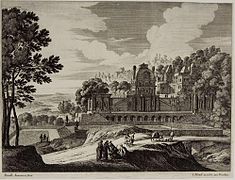
Grotto of Meudon in an imaginairy landscape, Harvard Art Museum, 34.1991 (The roofing of the central pavilion is fictive)
Château-Neuf (yeni kale)


We owe the plans of the Château-Neuf to the architect Jules Hardouin-Mansart. Philippe de Courcillon de Dangeau wrote May 21, 1706, that being at Marly, "the king worked in the morning with Mansart, who showed him the plans of the buildings that M. M. wants to make at Meudon at the place where the grotto is." Monseigneur wished this building to house the courtiers he received at Meudon, and the king aimed at the drawings made for Monseigneur. The building was erected on the site of the grotto, previously demolished in 1705.
A long corridor serves all the apartments: this was not unusual for the time. What was much more so was the systematization of the typical dwelling of the courtier, since the whole of the Château-Neuf can be compared to a "hotel" in the modern sense of the word.
After nearly two hundred years, a fire ravaged the building on January 31, 1871. The ruins were left to the inclement weather, and probably also looted, until 1879 when a law enacted the choice of Meudon as an observatory. Restoration of the ruins was then begun by the architect Sabit Moyaux, saving from destruction what remained of the castle, especially the two lower floors, less damaged by the fire.

Château-Neuf from the parterre. Mariette, c. 1715

Third level of the Château-Neuf ("le bel étage"), by Mariette, around 1715
Cutaway of the Château-Neuf, circa 1720. Mariette

Levels 2 and 4 of the Château-Neuf. Mariette, c. 1715
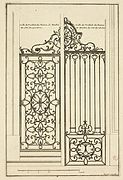
Grilles du Château-Neuf de Meudon. Mariette, A.F.

La grille basse du Château-Neuf, c. 1708 Musée-promenade de Marly-le-Roi.
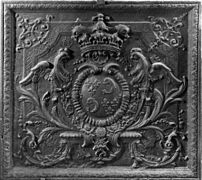
Taque foyère aux armes du dauphin, Château-Neuf, vers 1708. Musée d'art et d'histoire de Meudon
Photograph Château-Neuf, c 1860
Üst giriş

The chateau was reached by the upper vestibule on the forest side. It was Italian, pierced by an opening, which made it possible to clear its space. The door-tops were carved with children representing the four seasons, the representation of which is preserved by photographs of plaster models, molded on the originals (Vente Sardou).
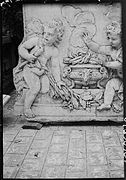
Winter, upper vestibule, 1708
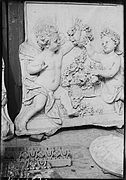
Spring, upper vestibule, 1708
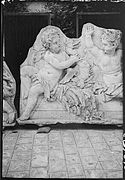
Summer, upper vestibule, 1708

Autumn, upper vestibule, 1708
Décor of the upper vestibule. Stockholm, NMH CC 1078
Pedestal of the vestibule. Stockholm, NMH CC 1073
Décor of the upper vestibule. Stockholm, NMH CC 1074
Detail of the cornice in the upper vestibule, National museum of Stockholm, NMH CC 1074
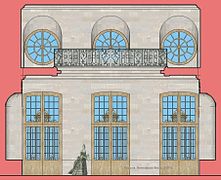
Cutaway of the upper vestibule, which functions as an Italianate salon
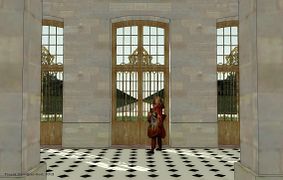
Reconstruction, seen from the upper vestibule
Alımı Portekiz Louis I tarafından Prens Napolyon, upper vestibule, 1867
Muhafız odası

This central room overlooked the flower beds through three rectangular windows (preserved bays). At its creation, it was lined with molded woodwork. On the mantelpiece was a copy of the David of Dominiquin. Louis XIV was particularly fond of this painting. Two paintings were ordered from the side exits: 1. a dog, and a greyhound, on the front in the middle of the game, scattered on the ground ducks partridges beccasses and hare in the middle A game-bag has a tree "; 2. a "hare that is attached to a tree by its left foot, on the left a dog at the feet of which are four partridges and a pheasant, on the front of the table a gun and its supply".

Cutaway of the guard room. Mariette. Shows positioning of the table of Desportes
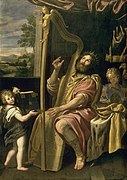
David, tarafından Domenichino, copy above the chimney
A sleeping dog, and a greyhound, François Desportes. 1709
A hare tied to a tree, François Desportes, 1709
İlk ön oda

In 1775, the piece is described in the following way: "Antechamber or dining room in suitte. Room illuminated by two windows in the Levant, paneling of apui, cornice carved. Chimney of white marble vene (...) Two paintings above the doors, painted on canvas. One represents a golden vase, set on a marble pedestal, with a garland falling in festoons, and fruits. On the pedestal are limes, grenades and grapes, crimson curtain and sky background, the other represents a golden bronze vaze, surrounded by a garland of flowers posed on a fullte of green marble, beside is a vase Of silver overturned with a figure of a woman in the form of an anchor. These two paintings are from Fontenay ". The middle of the room is adorned with "a table of black mastic with flowers and birds in the natural".
İkinci giriş odası

When the Château-Neuf was finished in 1709, on avait disposé two paintings ordered from Fontenay, comme pour toutes les autres pièces de l'appartement, ce qui uniformisait le décor, à savoir :"A golden vase with two handles, surrounded by a garland of fruit, placed on a table of porphire, which is furnished with grapes; On the right, a basket filled with Italian grapes, cucumber, pomegranate and flowers; on the left, a crimson curtain, behind which are several golden basins, one of which is surrounded by a garland of flowers."
A pyramid of fruit resting on a marble table, on which is a melon hung next to a pomegranate; On the right, on the same table, an orange tree in a porcelain vase; On the same table, on the left, a large golden vase surrounded by a garland of flowers, at the foot of which is another silver vase reversed, a golden dish, a corner of which is hidden by a purple curtain of the same dimensions as the preceding.
The inventory of 1775 indicates that it is a:
"Room illuminated by a cross in the Levant, paneled high, scultée, gilded and varnished on wood, cornice in plaster scultée and gilded idem. The chimney of green-campan. (...) Two paintings above the doors, painted on canvases, each of width on height. The first one represents Apollo and Daphne, this god pursues this nymph who takes refuge in the arms of his father's river Peneus (mythology). The second represents the triumph of Acis ve Galathea. The first of these paintings is by Antoine Coypel ikincisi Corneille (the elder)".

Apollo and Daphne, Antoine Coypel. Musée de Versailles
Acis and Galatée, Michel Corneille, Musée de Versailles
Monseigneur'un geçit töreni odası

The inventory of 1775 indicates for the parade chamber the following decoration:The room is illuminated by two windows on the east, wooden paneling, varnished and gilded on wood, sculpted and gilded korniş, large alcove supported on pilasters. Two paintings above the doors, painted on canvas, each 4 feet 9 inches wide by 3 feet 3 inches high. One represents a golden vase filled with different flowers, set on a marble ledge. In the background are two columns surrounded by garlands of flowers. The other represents a gold vase with a handle filled with different flowers, stoned on a stone fullteam, beside another vase. And on the other side a piece of drapery which falls on the edge of the full. These two paintings are by Fontenay. In this room is under the glass troughs two tables of green campan marble of long supported on feet consolle gilded and sculpted.
Originally, the alcove was decorated with the grotesque 12 months of Claude Audran III from the Gobelins, which still keeps nine of the twelve originals. The inventory of Crown furniture makes the following description:"A three-piece tapestry of low-woven tapestry, wool and evening, enhanced with gold and silver, manufactured in Paris, the Gobelins manufactory, the design by Audran, On twelve bands of daffodil, the divinities who preside at the twelve months of the year, under grotesque porticoes of different shapes, accompanied by the attributes of each divinity, grotesques, grooves and ornaments, with the sign of the month, separate daffodil bands By other narrower stripes, with a purple background, laden with mosaics, and the figures of Fransa'nın Louis, all of silver, the top and bottom borders like the bands Narrow, with silver shells and dolphins, the curtain containing 9 aunes 1/8 of course on 3 aunes ¼ high, made expressly for the chamber of Monseigneur, in his apartment of the new castle in Meudon."
Here is the list of the gods attached to the months groteskler:
- "January under the protection of Juno "
- "February under the protection of Neptün "
- "March under the protection of the god Mars ve Minerva "
- "April under the protection of Venüs "
- "May under the protection of Apollo "
- "June under the protection of Merkür "
- "July under the protection of Jüpiter "
- "August under the protection of Ceres "
- "September under the protection of Vulkan "
- "October under the protection of Minerva ve Mars "
- "November under the protection of Diane "
- "December under the protection of Vesta "

Coupe of the parade chamber in the Château-Neuf of Meudon, circa 1709
Elévation du fond de la chambre de parade, circa 1708, with the bed
Six des douze mois grotesques, de Claude Audran III, copy of the panneaux pour la tenture réalisée for Meudon. Sotheby's, 18 November 2010, New-York, lot 235

Design of the chamber woodwork. Nationalmuseum, Stockholm, NMH CC 2300
Projet (ultérieur ?) de décor pour l'alcôve (non Versailles), BNF
Balustrade in gilded wood from the parade chamber, circa 1708
Fotoğraf Galerisi

Cross-section of half the gallery of Monseigneur at the Château-Neuf in Meudon, condition in 1709. Nationalmuseum de Stockholm
Cross-section of half the gallery. Stockholm, NMH THC 5953
Plan of half the gallery, Stockholm, NMH THC 5954
Schéma de l'élévation de la galerie, Stockholm NMH CC 2855
Details of the cheminée et des consoles NMH CC 1105

Cyrus interrogeant le roi d'Arménie (Cyrus questioning the king of Armenia), Noël Coypel. Grenoble Müzesi

Néron au milieu d'un festin ordonnant la mort d'Agrippine (Nero in the midst of a Feast Ordering the Death of Agippinus), Noël Coypel. Grenoble Müzesi
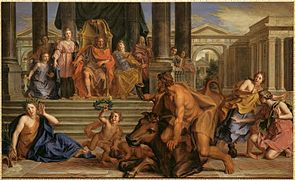
Herkül and Archélaos, Noël Coypel. Musée de Versailles

Herkül ve Déjanire, Noël Coypel. Musée de Versailles

Limonluklar
In order to protect the orange trees from the cold during the winter, two main orangeries were built at Meudon, the most important of which is the Château-Vieux.
Eski kalenin limonlukları
Traditionally, in French castles since the 18th century, an orangery is both a utilitarian building and a strong element of the monumental composition constituted here by the terrace, the Castle-Vieux and the loggia. Its dimensions determine the magnitude of the great perspective that extends from the castle to the plateau of Villacoublay.
The orangery was probably built between 1655 and 1659 by the architect Louis Le Vau, for owner of the estate Abel Servien, superintendent of finance under Louis XIV. Open to the south though eight high windows on either side of a monumental entrance, the orangery is intended to house the park's orange trees during the cold season. During the summer, orange trees were displayed on its floor around a rectangular basin, as well as on the grounds of the castle and cave. The orangery extends eastward with a bastion in coarse apparatus.
Renovated several times in the 19th century, then abandoned until 1980, the parterre of the orangery was restored between 1980 and 1984, to its 17th-century appearance.
L'orangerie of Meudon, 17th century. Restored in 2012
The nymphaeum above the orangery
Orangery of Meudon before restoration, 2010
Inside the bastion of the orangery, 2014
Yeni kalenin limonlukları
It was built at the same time as the Château-Neuf, between 1706 and 1708. It was demolished during the reign of Louis XVI.
Orangery of the Château-Neuf
Interior of Orangery, Château-Neuf
Orangerie du Château-Vieux'un altındaki sera
A third building was used for the conservation of shrubs during the winter. The "greenhouse" was located immediately below the bastion of the Orangery of the old castle in Meudon. There is still the wall at the bottom, enclosed, as well as a buttress. The rest of this building adjoins the back of the garden of the Museum of Art and History of Meudon.
Ahırlar


The new commons still exist today, perfectly preserved. They are located at the entrance of the estate, at the top of the avenue to the castle.They were built by extending an earlier building, the köpek kulübesi of Louvois.
The three inner courtyards connect through a clear central passage for horses. The stables have only one floor, attic, so as not to obstruct the view of Paris from the Pond of Bel Air above. Abundant dwellings for the castle staff furnish this floor.
All the stalls were rebuilt in the 19th century. Some still exist.
Today all of these buildings are assigned to the Observatoire de Paris, which prevents access to all visitors.The commons have a total area of 5,000 m² (2,500 m² on each of the two levels).To this must be added also the area of the adjoining guard-house, of 850 m².
Bahçeler

The gardens of Meudon were of great magnificence. There were high gardens and low gardens, not to mention the Grande Perspective. The Meudon Way describes the itinerary for discovering Meudon's points of view at the end of the reign of Louis XIV. They are classified as "slope gardens".
Büyük Perspektif



The Great Perspective is the monumental axis that organizes all the area of Meudon. It is perfectly rectilinear over a distance of 3.5 km, despite the unevenness of the terrain. It was created on both sides of the Château-Vieux, a place occupied from the beginning.
At its apogee, at the beginning of the eighteenth century, it was composed as follows (from north to south):
- Avenue du château (planted with four rows of trees)
- First ditches
- Front yard (on the right, terrace of the chestnut trees)
- Second ditches (buried under the terrace)
- Courtyard of the Château-Vieux, known as the royal court
- The Château-Vieux (destroyed, cellars preserved)
- The floor, designed by André Le Nôtre (yerlebir edilmiş)
- The Orangerie, of Louis Le Vau, with a circular basin
- The parterre of the Orangerie, with a rectangular basin
- Lawn, with a white marble statue, unidentified
- The basin known as the "Grand Carré" (destroyed)
- New lawn, shorter than first
- The water grid, with 10 jets of water (destroyed)
- Other lawn, longer
- The pond of Chalais (on the right, the carp channel)
- The Green Carpet
- The pavilion of Trivaux (under Louis XVI) (destroyed)
The axis ended at an alley drawn on the plateau of Trivaux.

Estampe d'Israël Silvestre représentant la Grande Perspective de Meudon depuis le tapis vert. Vers 1685.

Vue aérienne de la Grande Perspective de Meudon.

Vue aérienne par drône de l'avenue du château, en direction du nord.
Schéma de la Grande Perspective de Meudon, 2015. Légende : 1.Avenue du château ; 2.Grande Terrasse du château ; 3. Orangerie ; 4.Partie toujours bouchée ; 5.Étang de Chalais ; 6.Tapis Vert.
Alçak bahçeler

They were mainly developed by Louvois, and then embellished by Monseigneur and Louis XIV. Their difference in level and the different points of view made the charm, as well as the presence of many water bodies and thousands of topiaries. It was accessed from the "Grand Carré" basin:
- The floor of the Oval;
- On the left, the channel of the shadow;
- On the right, the half-moon;
- The wood of Guenegaud, with its pavilion;
- The basin of the octagon;
- Below, the "play of M. Le Nostre", framed by two cascades;
- In the background, the vertugadin, going up.
- On the left, Cleopatra's grove;
- The Arthelon canal
- The Arthelon waterfall
- The chestnut grove
- The Small Grotto of the Hotel Courtin
- The parterre of the Hôtel Courtin
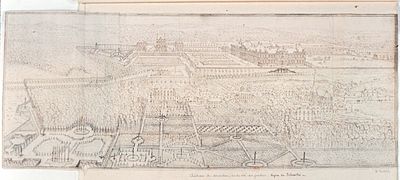
Les jardins bas de Meudon (The Low Gardens of Meudon), by İsrail Silvestre, 17th century, BNF
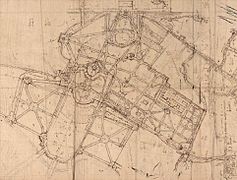
Detail of the low gardens on the draft plan for the gardens at Meudon. ADY (78). Circa 1697

Le bassin de l'Ovale, jardins bas de Meudon. Circa 1690
"Meudon. Les 2 châteaux réunis sous un même aspect", drawing by Jean-Baptiste Maréchal, 1785. View from the Ovale

Restitution 3D des jardins bas, avec la "pièce de M. Le Nostre". Condition circa 1700
Yüksek bahçeler

The area of the high gardens is nearly three times larger than that of the low gardens. The hold of these high gardens is still preserved today, occupied mainly by the Paris Gözlemevi. The gardens consisted of a labyrinthine network of walkways, embellished with numerous pieces of water. Unlike the low gardens, the high gardens were mainly flat, since organized on the hill of Meudon. Vardı:
- The parterre of the Grotto, then parterre of the Château-Neuf in 1708
- The Cradles, simplified in 1708
- The floor of the Globe
- The parterre des Bois
- The Calotte
- Şemsiye
- Gladyatör
- The Grove of the Cloisters
- The Bel Air Basin
- The gardens of Montafilan, with the stone cabinet
- The bastion of the Capuchins, which served as a point of view on Paris and Saint-Cloud.
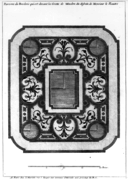
The parterre of the Grotto, engraved by Mariette
Quarter of the parterre of the Grotto. Nationalmuseum of Stockholm. Condition of parterre between 1680 and 1708
Recreated view from the "Parasol", circa 1700
South semi-circle of the Bel Air basin, 2010

Elévation du cabinet de pierre des jardins hauts de Meudon, du côté de Montafilan (près des Capucins). Nationalmuseum de Stockholm, NMH THC 377.

View from the bastion of the Capucins, Jacques Rigaud, circa 1730
Park ve göletler

The park of Meudon extended as far as Chaville, and thence reached that of Versailles. The elevation of the terrain, the dense forest, the numerous ponds, the great plains situated on the heights are the main features of this park in the 17th and 18th centuries. Bunlar dahil:
- The pond of the Garenne
- The Triveau pond
- The pond of the Fountains
- The pond of Vilbon
- The Renault Fosse pond
- The Tronchet pond
- The old tank
- The new tank
- The leg of Oye
- The farm of Vilbon, with the mills for the waters.
Note that the pond called Meudon was not created until the 20th century.
The historical library of the city of Versailles preserves a manuscript of the reservoirs of Meudon, with the arms of the Grand Dauphin, dating about 1700.
- Plans des réservoirs et étangs qui sont à Meudon, Bibliothèque historique de Versailles.

Binding with the arms of the dauphin

Giriş sayfası

Villacouplay pond

Tronchet pond

Villebon pond

New reservoir

Old reservoir

Bel air

Pond of the fonceaux

Pond of the garenne

Pond of Triveau

Trout canal

Pond of Chalais

Etang du loup pendu

the different levels

(süit)

(süit)

(süit)

(süit)

Binding with arms
Meudon köyü


The village of Meudon was made up of numerous hotels and properties, the most important of which belonged to characters linked to the owners of the castle. Bunlar dahil:
- Saint Martin's Church, (preserved)
- Otel Henri du Plessis-Guénégaud (yerlebir edilmiş)
- Hotel Bellon, (destroyed)
- Hotel Richer, (preserved)
- Hotel Tourmont, (preserved)
- The hotel of the Countess of Verrue (preserved)
- The castle of Fleury (destroyed)
- The country house of Mben mi de La Fayette in Fleury
- The folly of Jean-Jacques Huvé, (preserved)
- The villa of Jean-François Jacqueminot
- The Gallyot hotel in Fleury, (destroyed)
- İn evi Pierre-Joseph Redouté
- The house of Bastide, then house of Bailly. (Yerlebir edilmiş)
- Manastırı Capuchin Friars Minor, the first of this order installed in France by the care of the Cardinal of Lorraine
All these buildings and gardens were visible from the castle or its gardens.
Referanslar
- ^ Sometimes written "Ysbarre"
- ^ http://www.persee.fr/web/revues/home/prescript/article/bec_0373-6237_1927_num_88_1_452416
- ^ Mirot, Léon (1927). "Études Lucquoises". Bibliothèque de l'École des Chartes. 88: 275–314. doi:10.3406/bec.1927.452416.
- ^ http://parismoyenage.fr/parisiens/nom_p.php?search=Isbarre&nom=Isbarre&prenom=Augustin
- ^ Carroll 2009, s. 88-89.
- ^ http://dumas.ccsd.cnrs.fr/dumas-01092058/document
- ^ Le Chant Pastoral de Ronsard évoquant la Grotte de Meudon.
- ^ See Memorial of 27 July 1618, AN, MC, XXIV, 132
- ^ https://www.louvre.fr/en/oeuvre-notices/mercury-abducting-psyche
- ^ Internet Archive - LE SIÈCLE DES BEAUX ARTS ET DE LA GLOIRE ou LA MÉMOIRE DE LOUIS XIV JUSTIFIÉE DES REPROCHES ODIEUX DE SES DÉTRACTEURS OUVRAGE OU SONT PASSÉS EN REVUE LES PRINCIPAUX AUTEURS QUI ONT ÉCRIT SUR LE RÈGNE BU GRAND ROI DEPUIS 1715 JUSQU'À NOS JOURS - ANCIEN SECRÉTAIRE DES ARCHIVES DE LA COURONNE - VERSAILLES CHEZ DUFAURE IMPRIMEUR RUE DE LA PAROISSE 21 - 1838
- ^ https://gallica.bnf.fr/ark:/12148/btv1b530874353.r=chateau+de+petit+bourg.langFR
- ^ The day after the feasts of Pentecost (the day of the arrest of Voltaire ), the Czar passed through Les Invalides on the way back from the château de Meudon, where he was said to have desired to take saddle, and being on a pierced chair, asked for paper from the valet who had brought it to him; the latter having none to give him, the prince used an écu of one hundred sols instead, presenting it afterwards to the valet, who declined it saying that the kapıcı had forbidden him from accepting anything from anyone; on seeing which the Czar, after having told him several times to take it, threw him, full of villainy to the ground. kapıcı, having heard the account of the valet, told him laughing aloud: "Go on, go, when you will have washed this écu, it will be as good as any other: I am confident that you lacked paper in order to profit from this écu, to give yourself the means to drink to the health of the prince with your comrades." Journal de la Régence, Jean Buvat, 17 May 1717
- ^ Michelet (Histoire de France, volume 17, Lacroix & Co., 1877, p. 155) suggests that the Regent ceded the castle of Meudon to his daughter on learning she was pregnant: a prolonged stay at Meudon would allow the young widow to wait out this new pregnancy and give birth with discretion, away from the prying eyes of courtiers and gossipmongers.
- ^ The Regent's strategy failed: even in the final months of her pregnancy, the Duchess did not give up her daily rounds of entertainments and sensual debauchery, overindulging in copious suppers washed down with much wine and liquor. On 28 March, her labor pains began at her Palais du Luxembourg, allegedly after a carnal night of pleasure and heavy drinking. Ill-prepared by her licentious lifestyle, she found her labour harrowing and lengthy. Saint-Simon sarcastically describes this perilous childbirth, which provoked a great scandal and was seen as divine punishment for Berry's very sinful life. It seems that she went into preeklampsi and seemed about to die. The Abbé Languet de Gercy, parish priest of Saint-Sulpice, refused to administer the Holy sacraments. On April 2, Berry delivered a stillborn child, and was thus relieved of her "dangerous indigestion" (as the official version of her "illness" put it).
- ^ According to Saint-Simon (Memoires(Memoirs) VII, 456) the autopsy found that "the poor princess was pregnant". As Duclos remarked (Œuvres complètes (Complete Works), 1821, Vol.6, p.369) "she wasted no time after giving birth". The "fertile Berry" (one of her sobriquets in the satirical poems embroidering her illegitimate pregnancies) apparently again became pregnant during her convalescence at Meudon, the month following her very arduous labor at the Luxembourg.
- ^ http://chateau-meudon.wifeo.com/stanislas-a-meudon.php
- ^ https://www.musee-lorrain.nancy.fr/fr/la-lorraine-pour-horizon/catalogue-numerique/declaration-de-meudon-109
- ^ Frédéric d’Agay (éd.), Journal de voyage de l’abbé Cavalier de Fréjus à Paris et Versailles (février-juin 1748). Unpublished annotated document online at CourdeFrance.fr, 1 September 2008 (http://cour-de-france.fr/article497.html )
- ^ Inventory preserved in the INHA library, carton 46, file XII, microfilm 24170-24198
- ^ "Les collections du département des arts graphiques - Retour de la promenade de Mr le Dauphin au vieux château de Meudon - ISABEY Jean-Baptiste".
- ^ Emile Dard (1905). Perrin et cie (ed.). Le général Choderlos de Laclos, auteur des liaisons dangereuses, 1741-1803 [General Choderlos de Laclos, author of Liaisons dangeureses 1741-1803] (Fransızcada). Paris. s. 516.
- ^ http://restaurermeudon.wifeo.com/images/p/pot/potentiel-archeologique-meudon-oct-2012.jpg
Kaynaklar
- Carroll, Stuart (2009). Martyrs and Murderers, The Guise Family and the Making of Europe. Oxford University Press.CS1 bakimi: ref = harv (bağlantı)
- Fiske Kimball, Rokoko'nun Yaratılışı, (Philadelphia Museum of Art) 1943.
Dış bağlantılar
- The Web page about the "Château de Meudon" (Fransızcada)
- Châteaux de Meudon (Fransızcada)
- Engravings of the Château de Meudon.
- Construction of the Observatoire de Paris at Meudon. (Fransızcada)
Koordinatlar: 48 ° 48′18″ K 2°13′52″E / 48.80500°N 2.23111°E






























